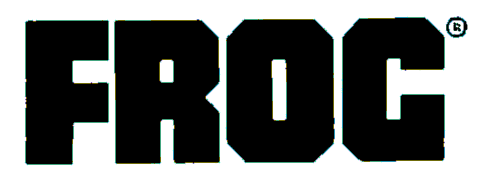
FROG F189 Black Series Hawker Tempest The fighter plane that beat the flying bomb! 1967-69
Rovex Scale Models Limited, Margate, Kent
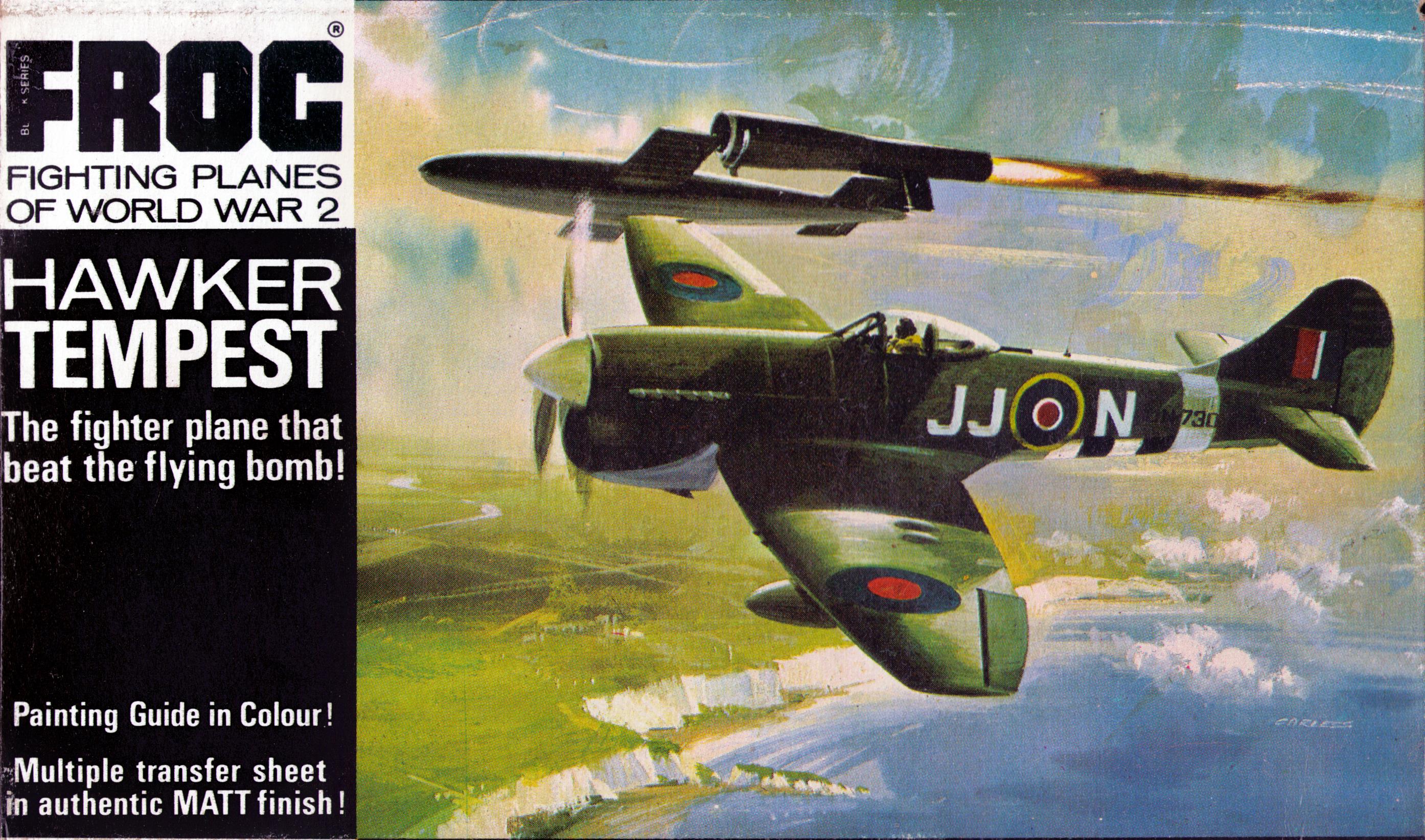 |
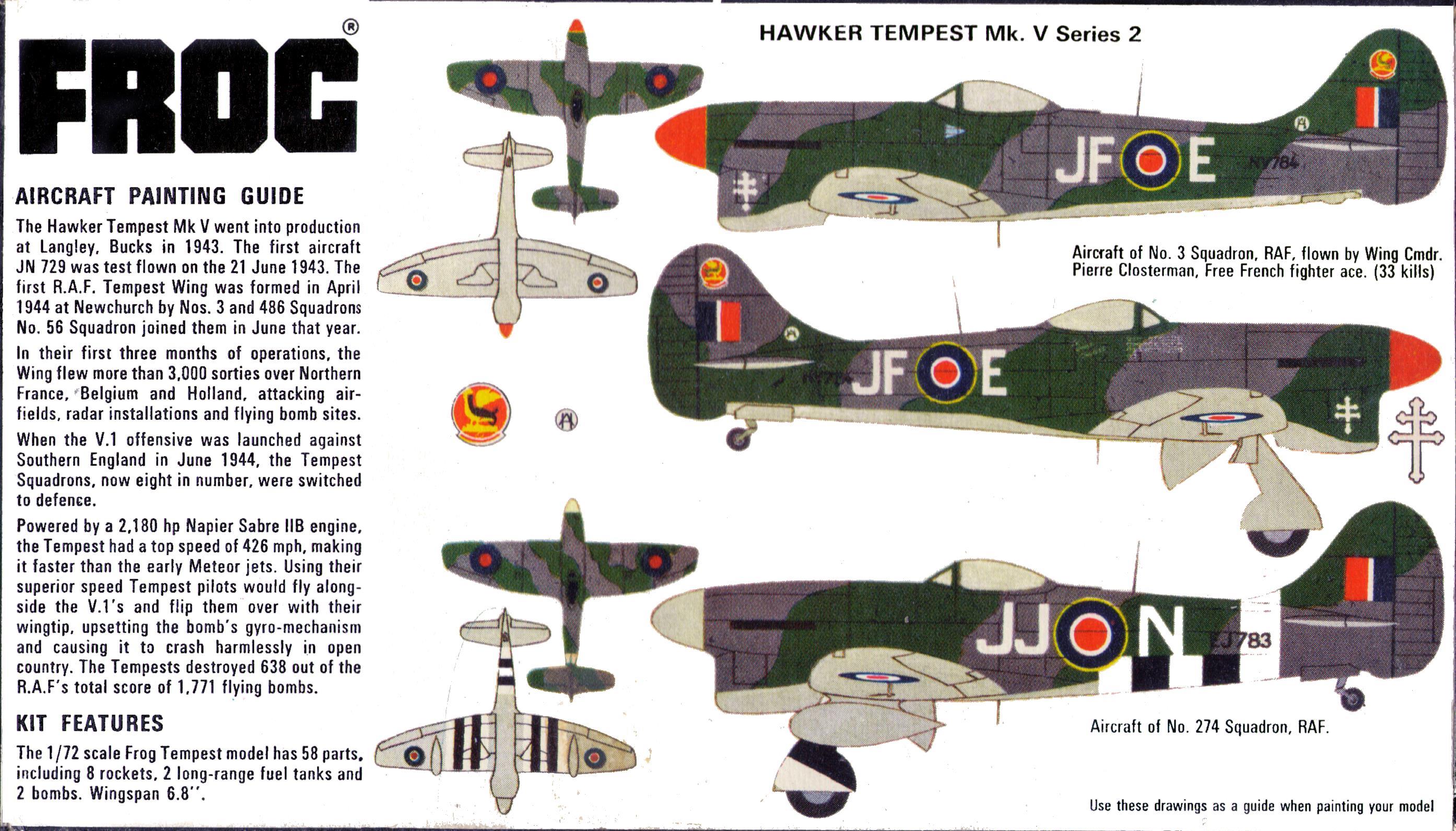


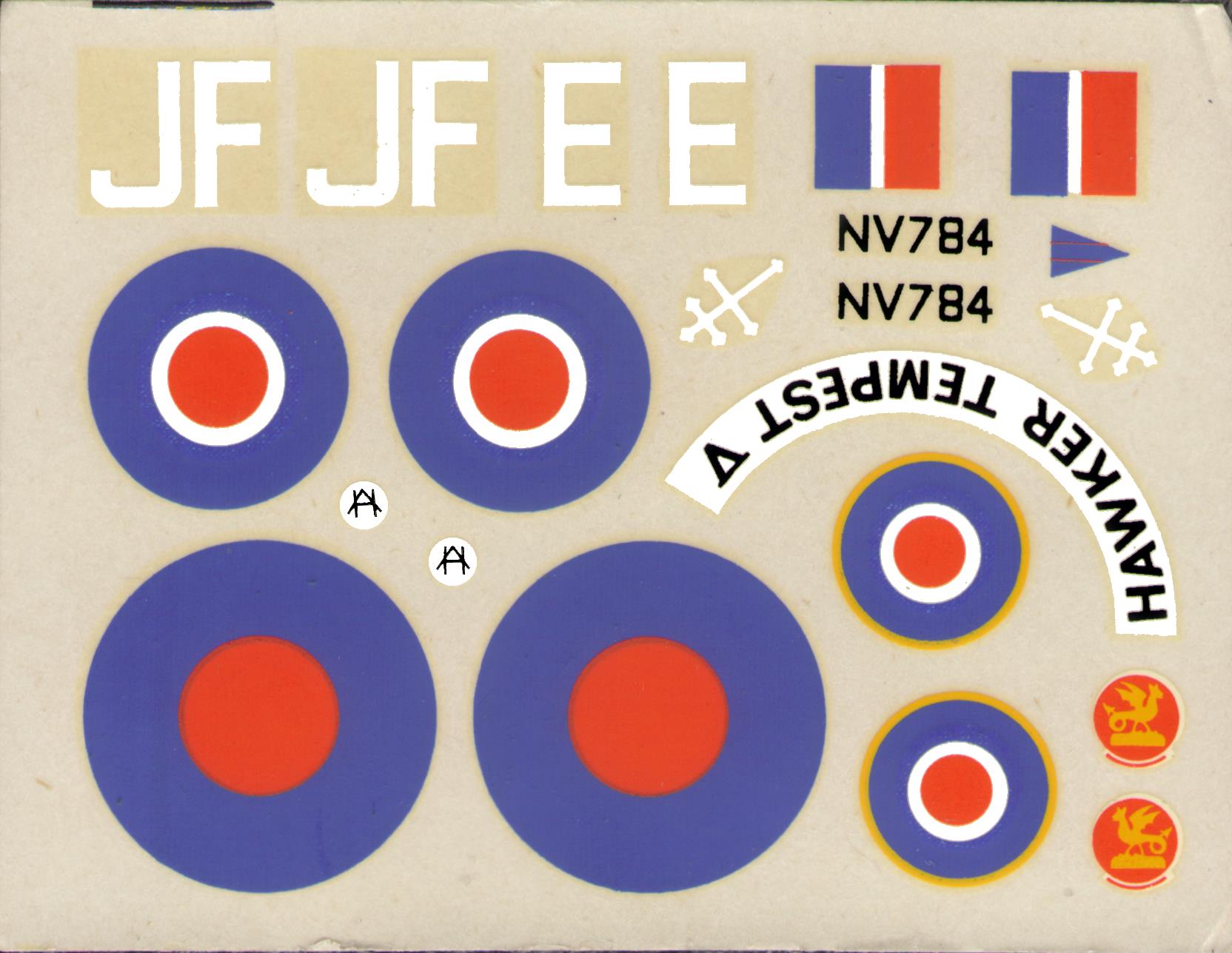
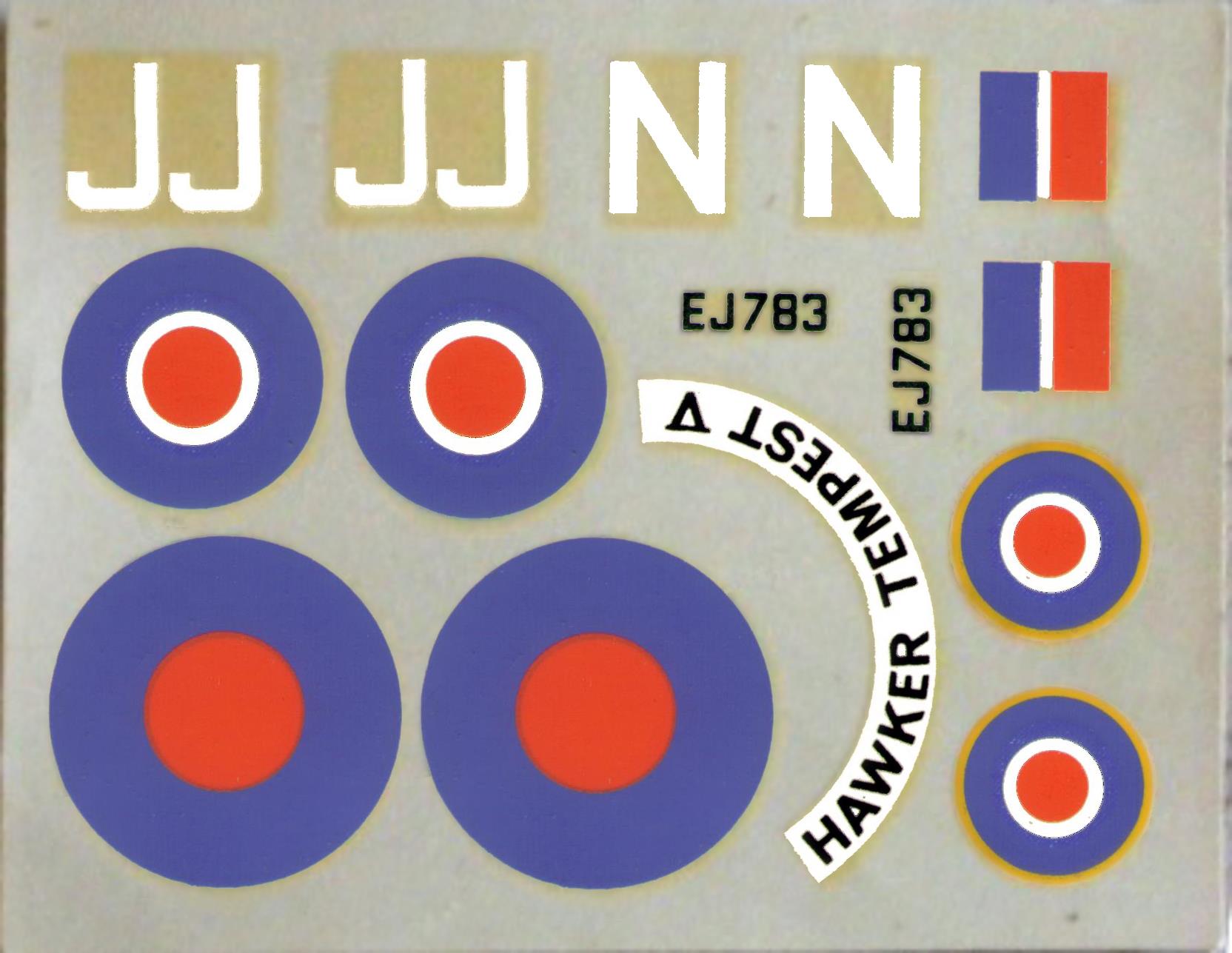
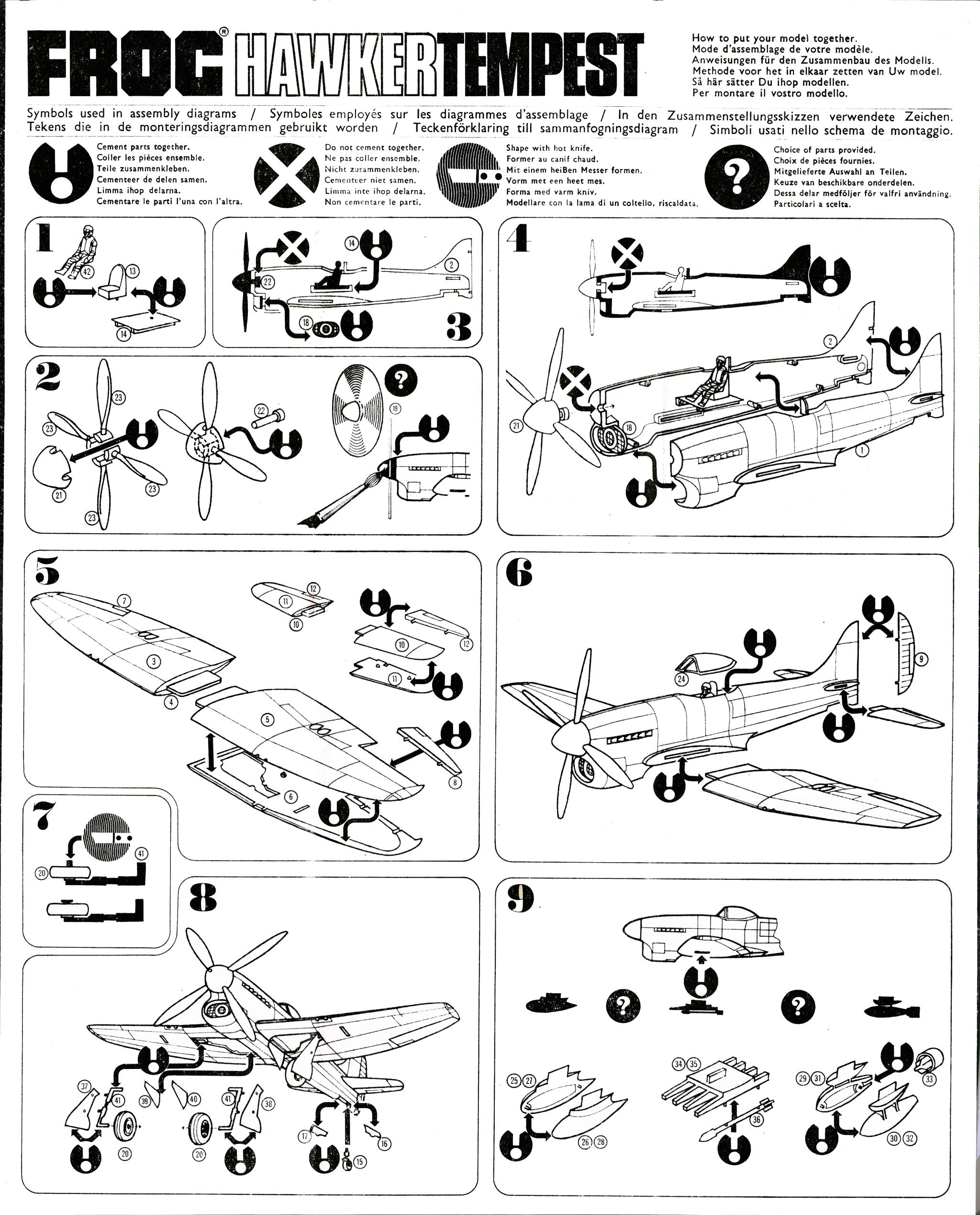
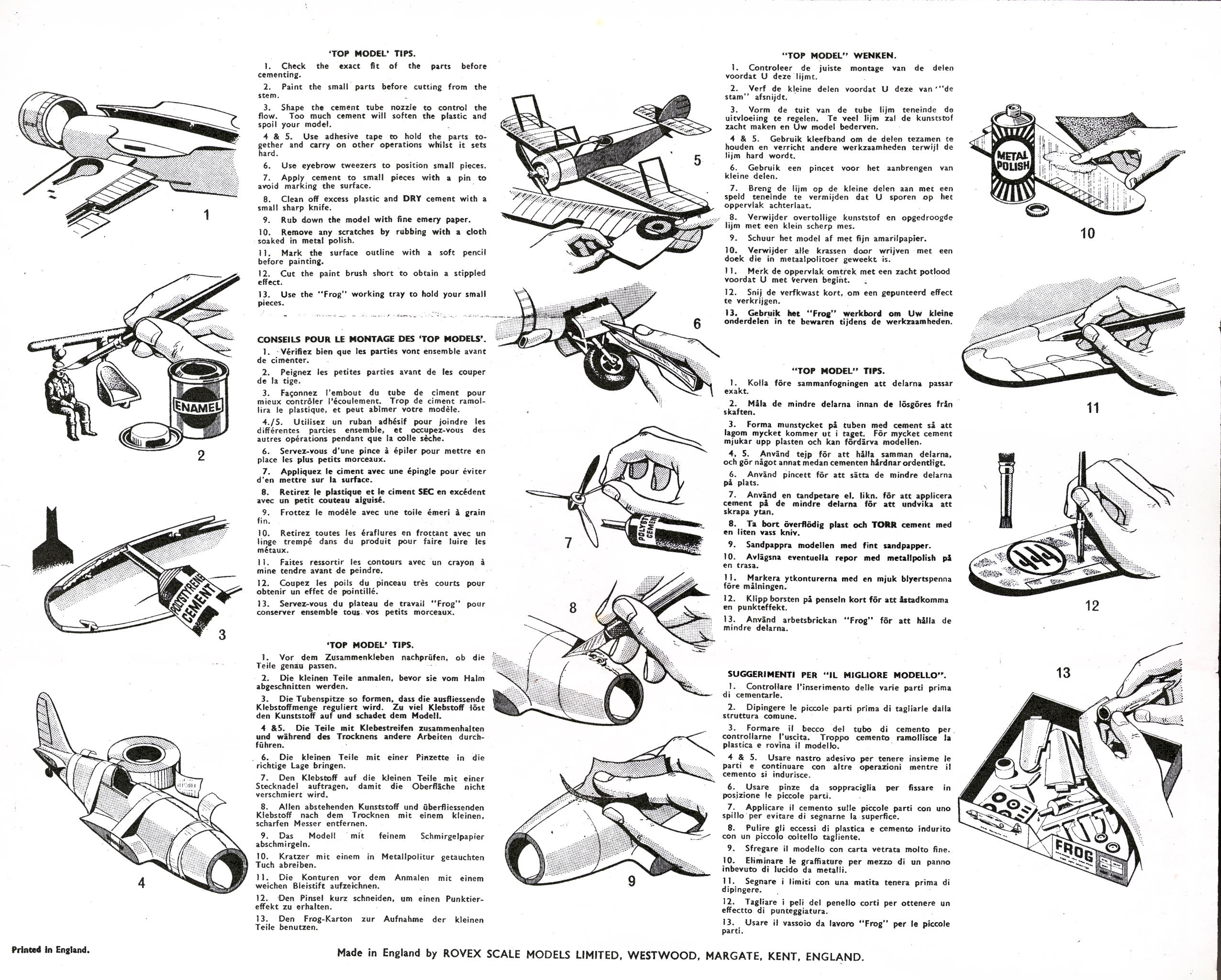
|
IN VIEW
Frog. This company will soon release a 1/72nd scale Tempest Mk.V and a large-scale British type Lifeboat. Having seen much of their programme for 1967, we can say that a lot of modellers will be delighted with the varied selection of kits that will be appearing, apparently with far more regularity than over the past few months.
The IPMS magazine, Vol.4 No.1, JANUARY 1967
THE FROG TEMPEST
Model talks
Like the curate's egg. Frog's 1/72nd scale kit of the Hawker Tempest is good in parts. It is accurate: it is neatly pressed, and it is simple to assemble. On the other hand, the surface detail, which is of the straight line type, is too heavy, and the red and blue used in printing the transfer sheet are too light.
A very interesting feature of this kit is its instructional sheet. This relies entirely on symbols rather than written instructions. At first sight our reaction was adverse. But a more thorough investigation showed that the sheet is easy to understand and, what is more, the symbols are explained in six languages. So much for the insularity of the British. We heartily congratulate Frog on an ingenious idea and one that we hope will be widely plagiarised by other kit manufacturers. The three-view colour drawings on the Tempest box are very good indeed, and at 2s 7d in the UK the kit is good value for money"
W.R.Matthews
Flying Review 1967-06
NEW AND IN VIEW (Aircraft Kits)
FROG. Hawker Tempest V. l/72 scale. Price c(UK) 2|7d.
The general shape of this model is accurate, "but the very heavy panel joint lines require sanding down to obtain the flush-riveted appearance of the full-sized aircraft.
The parts fit well on the whole, but the tail plane/fuselage joint requires a good deal of filling and filing to obtain a smooth fit, the fairing moulded into the fuselage being considerably deeper than the rest of each tail plane half. In fact, it would have been far better if the tail plane assembly has been the same as that on their earlier Typhoon kit, where a one-piece unit slides through slots in the fuselage halves; it is certainly simpler to fill the small gaps that this method leaves rather than to have to make the Tempest components fit properly. The cockpit canopy is very good indeed, being of the, correct shape and an excellent fit, though the armour plate behind the pilot's seat, which is included in the fuselage mouldings, needs thinning down.
One rather odd omission is that of the four cannon barrels. The holes for these are included in, the wing mouldings, however, and they can be made from scrap sprue suitably trimmed.
Included in the kit is a one-piece clear spinner with solid circular propeller disc, on which are scribed lines supposed to represent a whirling propeller. This thirty-year-old gimmick is obviously aimed at the younger modeller, and this particular piece of the kit is wasted as far as most of us are concerned. Happily, the alternative solid spinner with its individual propeller blades is excellent.
The instruction sheet is an entirely new departure. It consists of several exploded views, each covering various stages of assembly, but instead of written instructions to accompany these, symbols with meanings such as "cement here" are placed against the parts shown in the drawings. The meanings of the symbols are explained in six languages at the head of the sheet. Though odd at first sight, the sheet is easy, to follow, and overcomes language difficulties neatly. On the back of the instruction sheet appears a text, also in six languages, covering general assembly and hints and tips for improving or simplifying modelling methods.
The box art features an attractive drawing of a Tempest V of 274 Squadron RAF dealing with a V-1, and the back of the boxj has side and plan elevations of both this aircraft and also that of Pierre Clostermann when he was with No. 3 Squadron R.A.F.; decals are included for Clostermann's aircraft but not for the 274 Squadron machine. The decals are flat matt and of better than average quality; it is, however, necessary to repaint the code letters as these are shown as being white when in fact they should be a very light grey or Sky type 'S' colour. The blue used in the roundels is also too light.
The kit includes two bombs, two drop tanks, eight rockets and the rails for these. The rockets themselves are fairly near scale, but the rails are far too thick. In fact, both, aircraft illustrated on the box were used strictly in the fighter role, therefore strictly speaking only the drop tanks are correct. Bombs could, however, be fitted without looking too much out of place and like the tanks they are most attractively moulded."
The IPMS Magazine, March 1967
Hawker Tempest F. V Srs.II
| F189 | 1967-1969 | F2(K) | 115000 | 2xRAF |
| F189F | 1968-1974 | J2(K) | 320000 | 2xRAF |
| F212 | 1974-1977 | H(B) | 85000 | 2xRAF |
Originally included a clear plastic disc to simulate a spinning
propeller, but this was deleted in late 1973.
FROG model aircraft 1932-1976, R. Lines, L. Hellstrom
|
|
|
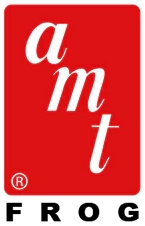
Hawker Tempest V AMT 3956 Famous fighters series II combo kit 1968-69
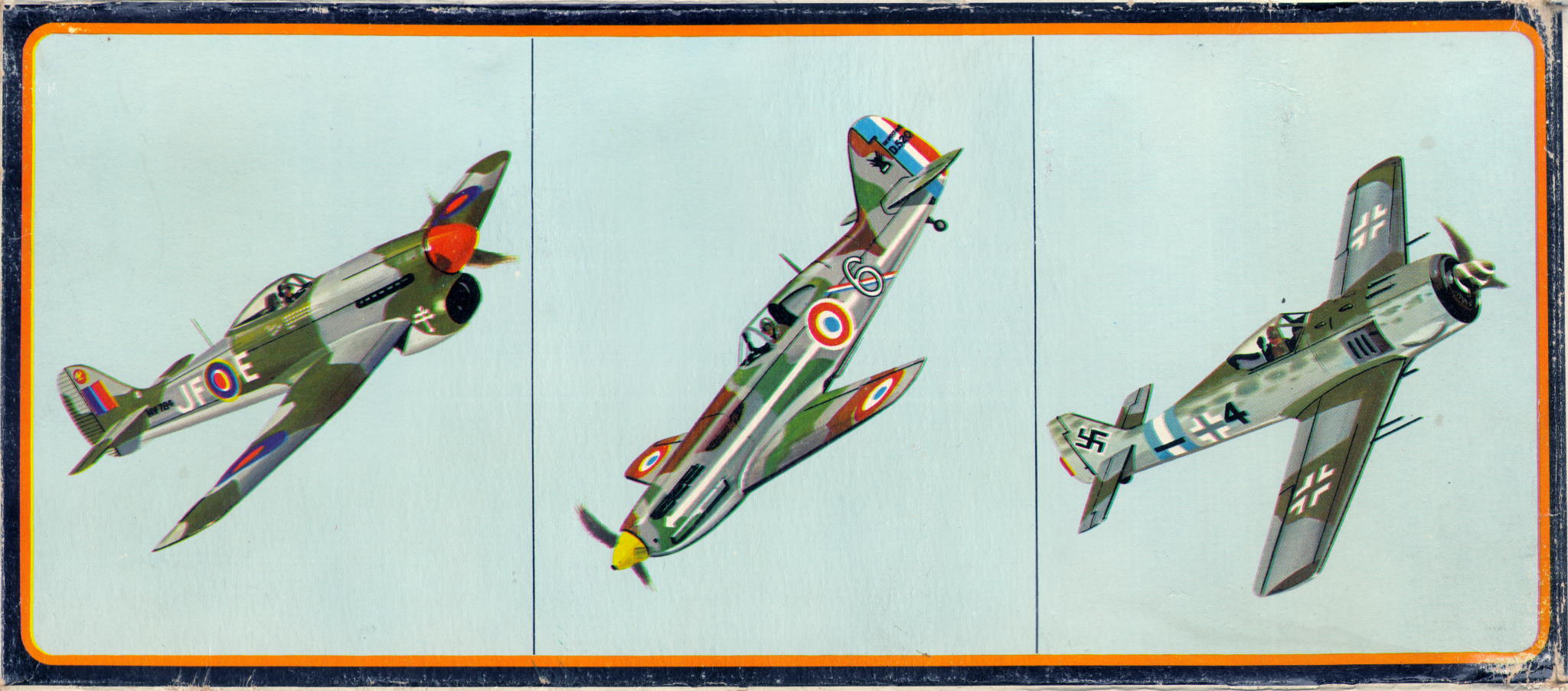
|



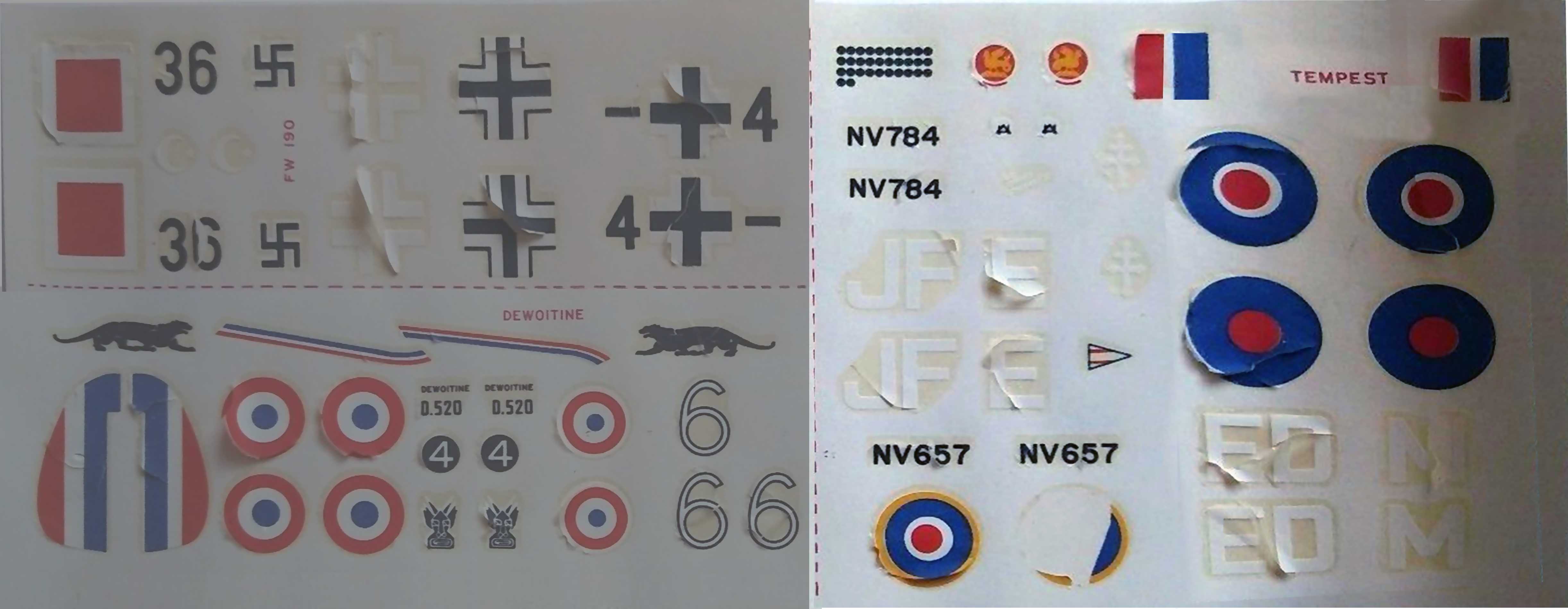
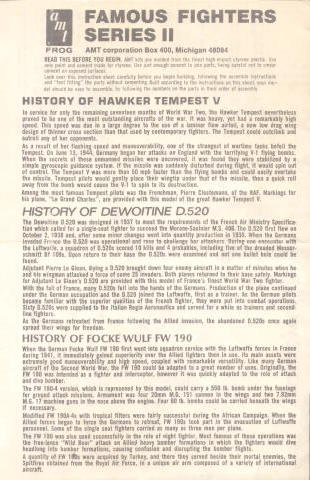
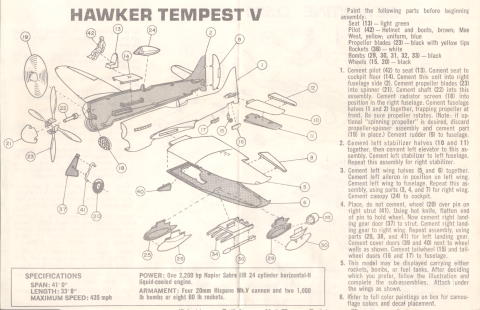
|
AMT Frog
AMT Corp., 1225 East Maple, Troy, MI 48084, USA.
Period: 1967-1970
AMT was, and has continued to be, a company specialising in car and truck kits. By the mid-1960s, they had become interested in diversifying into aircraft kits as well, and were thus a natural new partner for Lines Bros, after the demise of Air Lines. AMT sold the kits under the AMT/Frog label and, apart from a batch supplied by Rovex in 1968, did all moulding themselves, using Frog moulds brought over from England.
The original plans called for some 40+ Frog kits to be released by AMT, but eventually only 23 different kits got produced. While having the moulds with them, AMT had several of them (P-47, FW 190 etc.) cleaned up by removing engraved markings and other heavy surface detailing...
At first all kits had kit numbers type 0000, but around 1968 this was changed to A-000 for both older releases and new items. Most artwork and decals were changed at the same time.
| 1st no. | | 2nd no.
| | 3956 | + | A-642 | Famous Fighters Series II3 |
3 Hawker Tempest, Dewoitine D.520 and Focke-Wulf FW190A
FROG model aircraft 1932-1976, R. Lines, L. Hellstrom
|
|

Bagged FROG F189F Hawker Tempest Mk.5, 1969-72
|
|
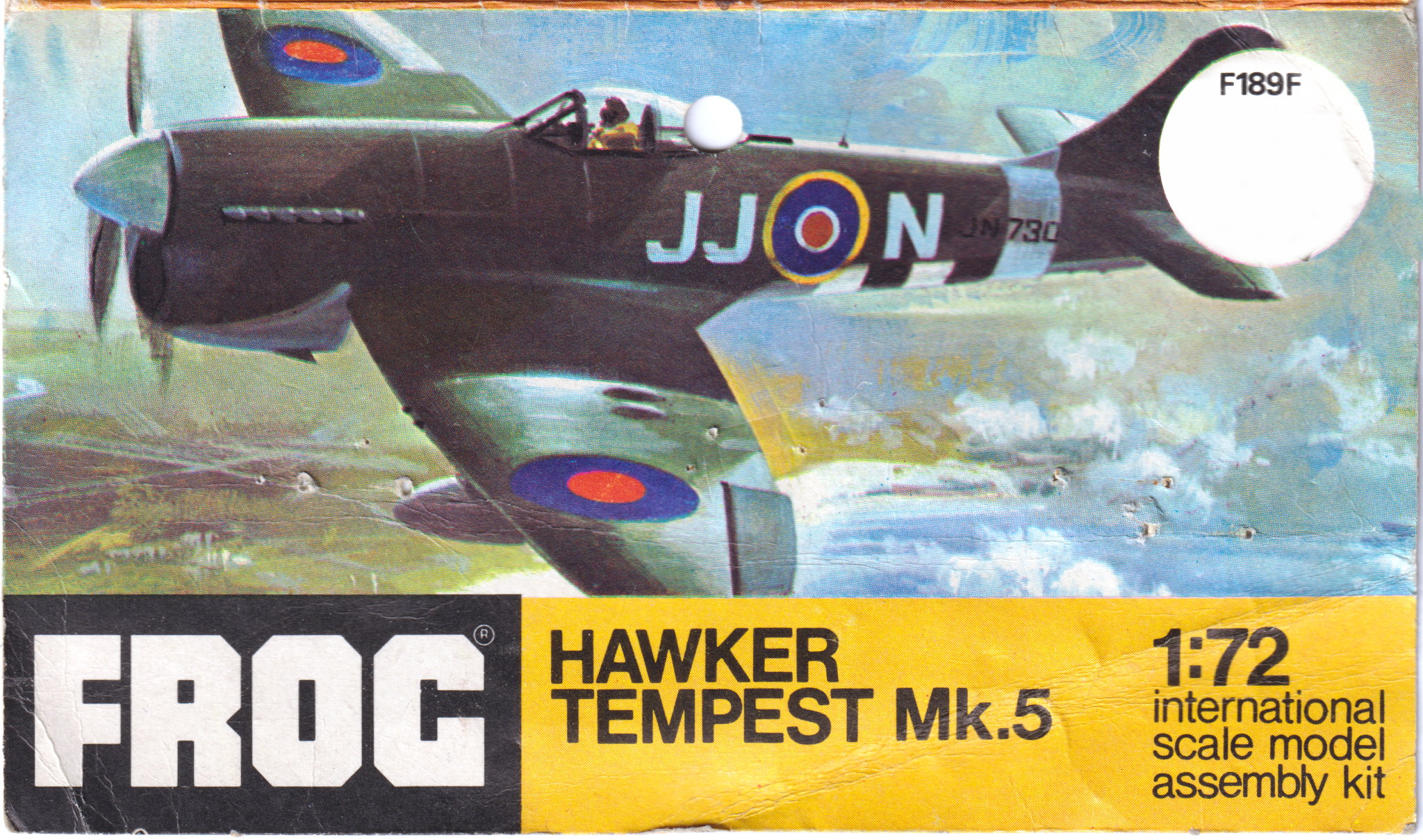
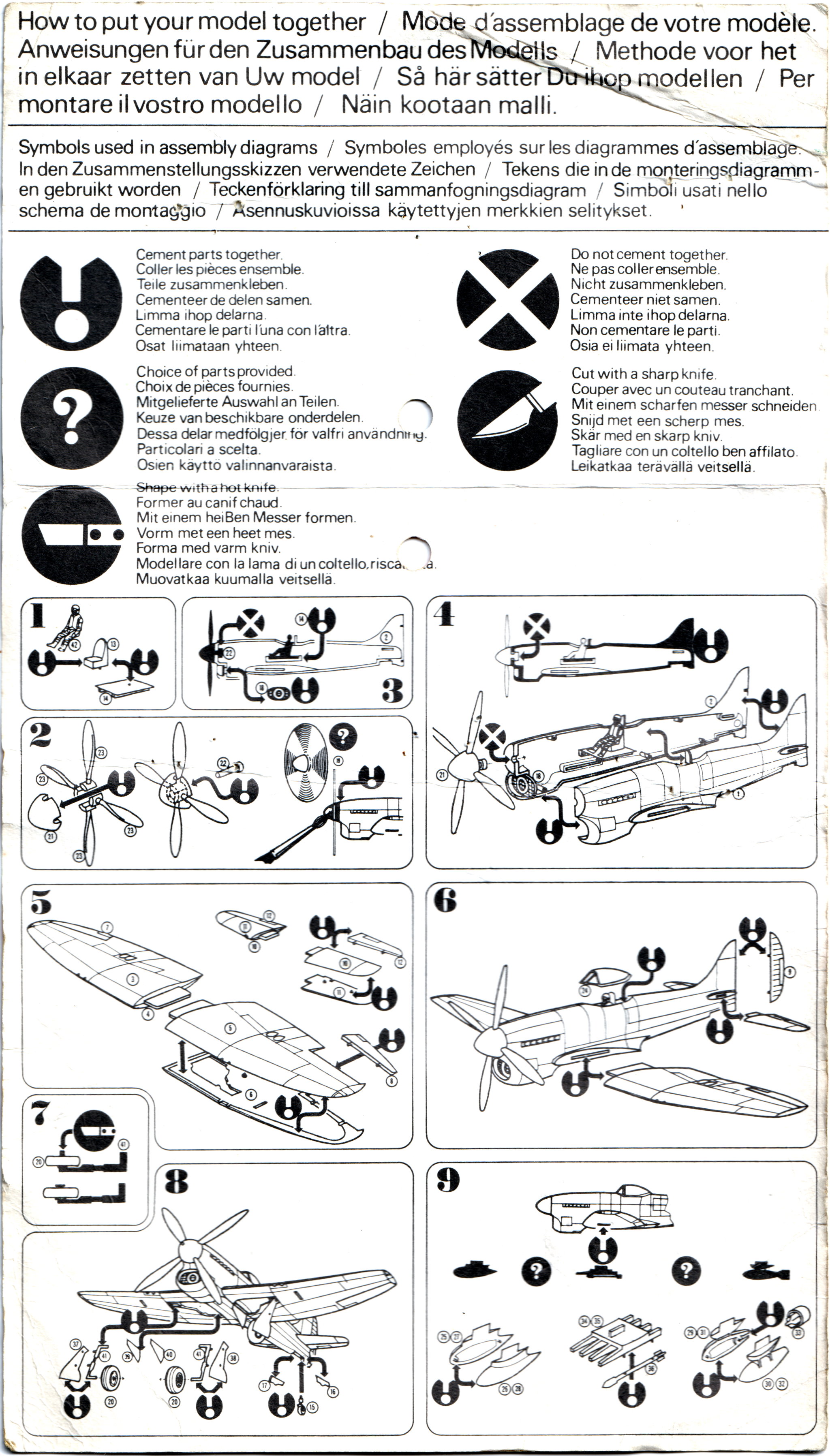
|
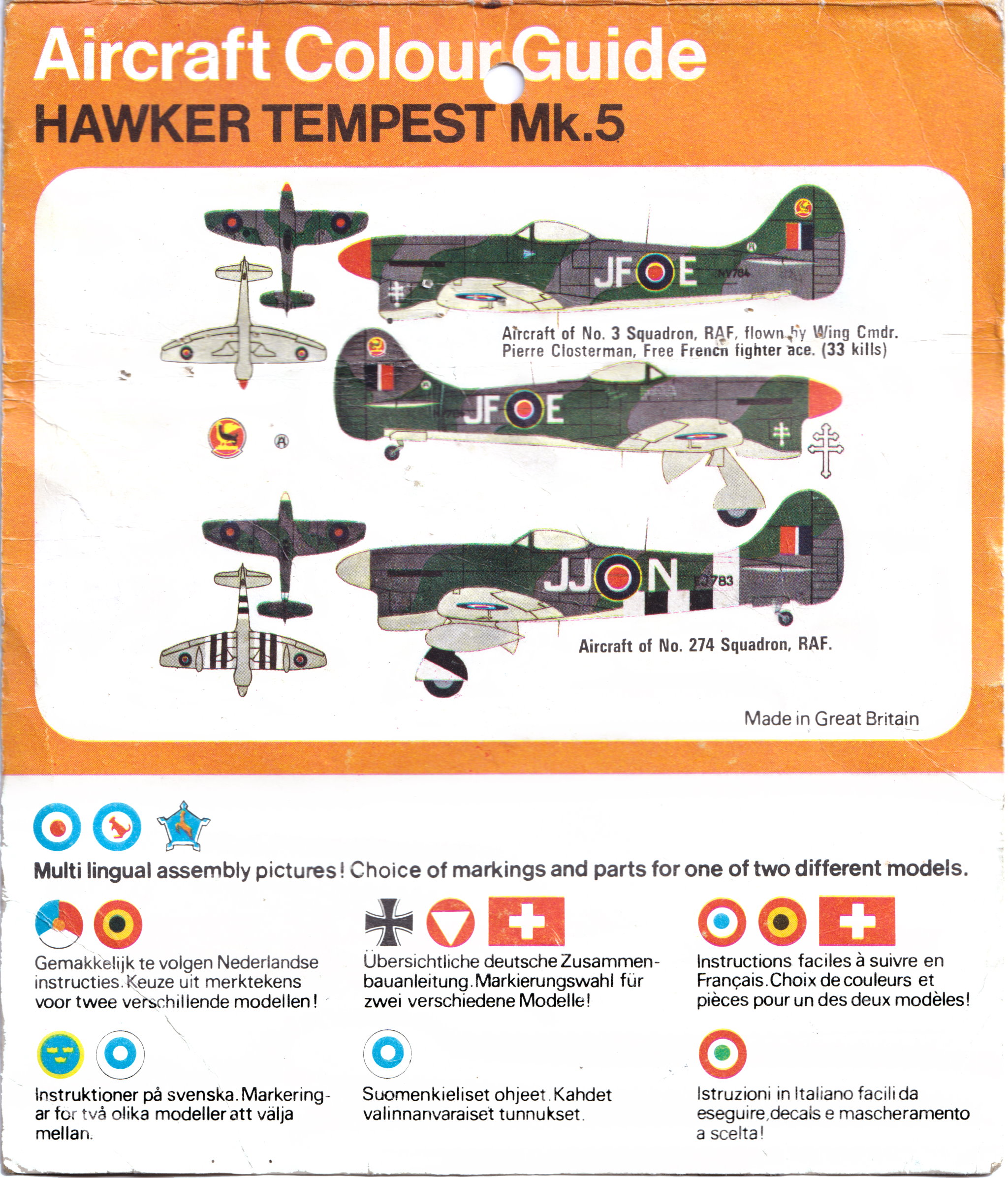
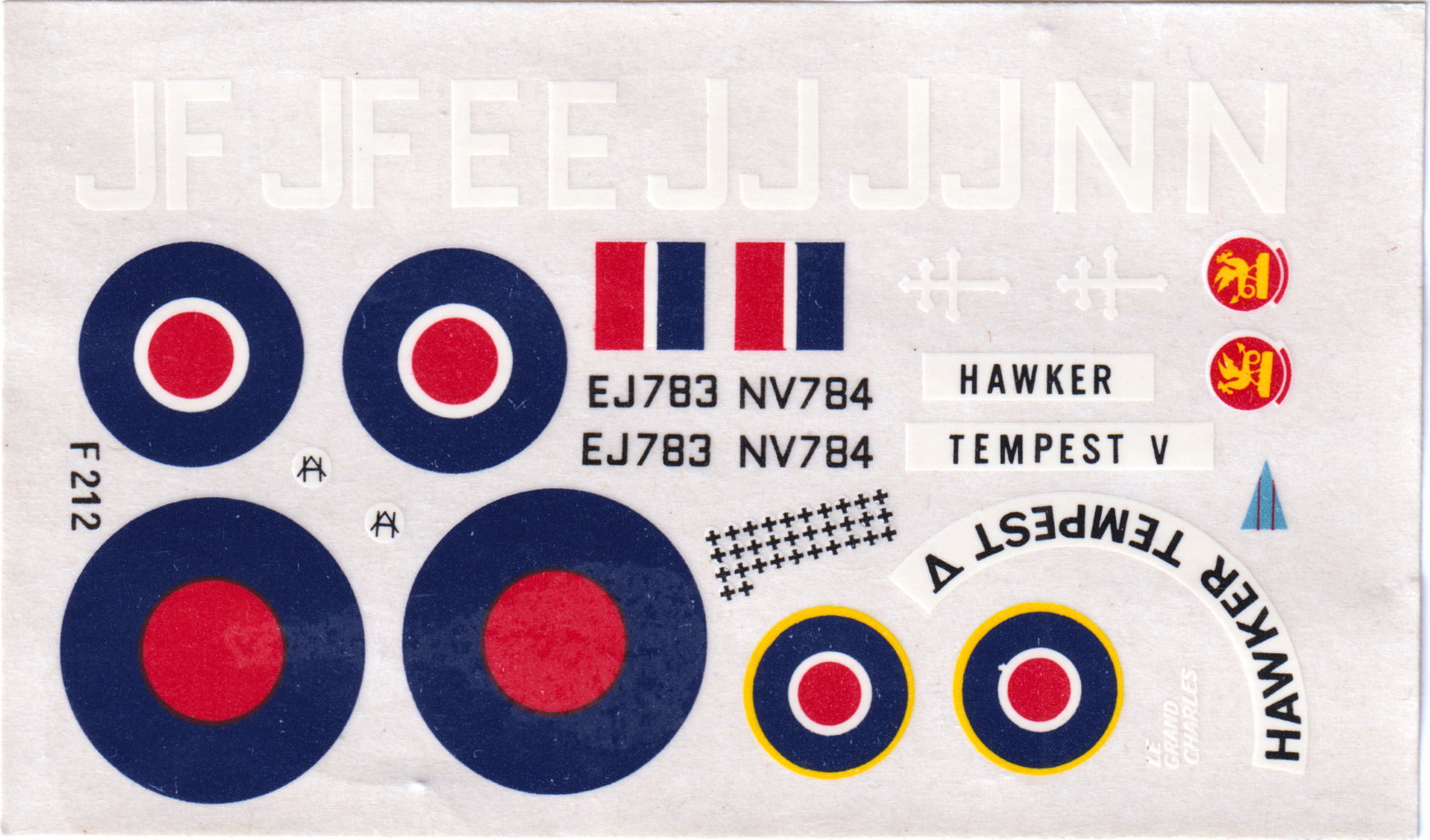
The IPMS magazine, February 1969
NEW AND IN VIEW NEW AIRCRAFT KITS
FROG. For some little time now rumour has had it that Frog were revising and updating many of their older kits, and at the Brighton Toy Fair rumour became fact with the release of those described below. Retailing at 3/- each in a new clear plastic pack, complete with coloured dramatic art on the front and the now very popular Profile style drawings on the back of the display card, these will certainly catch the eye in any model shop display.
Each kit has had all traces of the original surface detail removed and replaced by fine and accurate new detail. Unfortunately, costs have prevented full corrections, and such refinements as cut-out wheel wells are still omitted. Cockpit canopies have received attention where necessary and are far better than in the original kits, while completely new markings and insignia are given, two alternatives being provided for each type as follows :-
Tempest V F189F
Tempest V
- W/Cdr. Pierre Clostermann's aircraft, 3 Sqdn. R.A.F.
- 274 Sqdn. R.A.F.
The very high standard of decals common to all Frog kits of recent months is maintained in these 'packaged' kits. All are matt or semi-gloss with excellent register, and the minute detailing, such as that on 'kill' markings or the MC 202 insignia, is clearly readable if one uses a magnifying glass.
It is to be hoped that other kits from the Frog range will be upgraded similarly as time goes by, and we look forward to these in due course.
The IPMS magazine, February 1969
New Kits and models.
NEW LAMPS FOR OLD.
COMMENDABLE venture by Frog is the revision of many of their older kits of 1:72 scale aircraft models, which have just been re-issued in a new scries in polythene bags. All the moulds have been 're-worked' very deftly to eliminate such features as etched marking positions, which marred some of the older items, and add accurate new panel detail and other surface improvements. We reviewed the old Fw 190 which had been so treated a few months back. Now this kit also appears in the 'bagged' series together with all the following: Hurricane, Tempest V, Me 109F, Typhoon, P-47, Zero, Spitfire, Sea Fury, Fokker D21, MS 406, and Macchi MC 202. Big new feature is the provision of completely new, splendidly accurate and imaginative transfer sheets, each of which gives a choice of two sets of markings. We had two samples from the range, the Spitfire and the MC 202. The Spitfire has transfers for cither a Mk I of No 19 Sqn in September, 1940, or Bader's Mk Va of 1941, the quality of the new markings being excellent. Fine details include walkway markings and stencilled maintenance instructions and the modest price of the kit, 3s, would not be unreasonable for the transfer sheet alone! Whichever markings the modeller uses, he gets a spare set of value for other models. The MC 202 has a similar choice of two colourful marking schemes, probably the most accurate yet for a model of an Italian aircraft. The only improvement not possible, it seems, on the older Frog kits is the etching out of the 'solid' wheel wells, though the average modeller can do this himself, or use solid black transfer sheet which is surprisingly effective.
This improved Frog Spitfire is certainly a 'good buy' (even with the 'solid' wheel wells), which captures the graceful character of the early Spits absolutely perfectly. Added feature of all the kits is a colour plan on the card backing sheet which acts as a painting guide for the model. On our Spitfire, however, the printing was poor and the colour guide would confuse a novice who knew nothing about camouflage of 1940! This 'new lamps for old' policy by Frog is most refreshing and should be welcomed by 1:72 scale aircraft builders. Our samples, at 3s each, came from Jones Bros of Chiswick who can supply the whole range by post.
C.O.E.
Airfix Magazine, June 1969, Vol.10 No.10
|
|

FROG F212 Hawker Tempest Mk.5 Fighter-bomber, Rovex Models and Hobbies, 1974-77
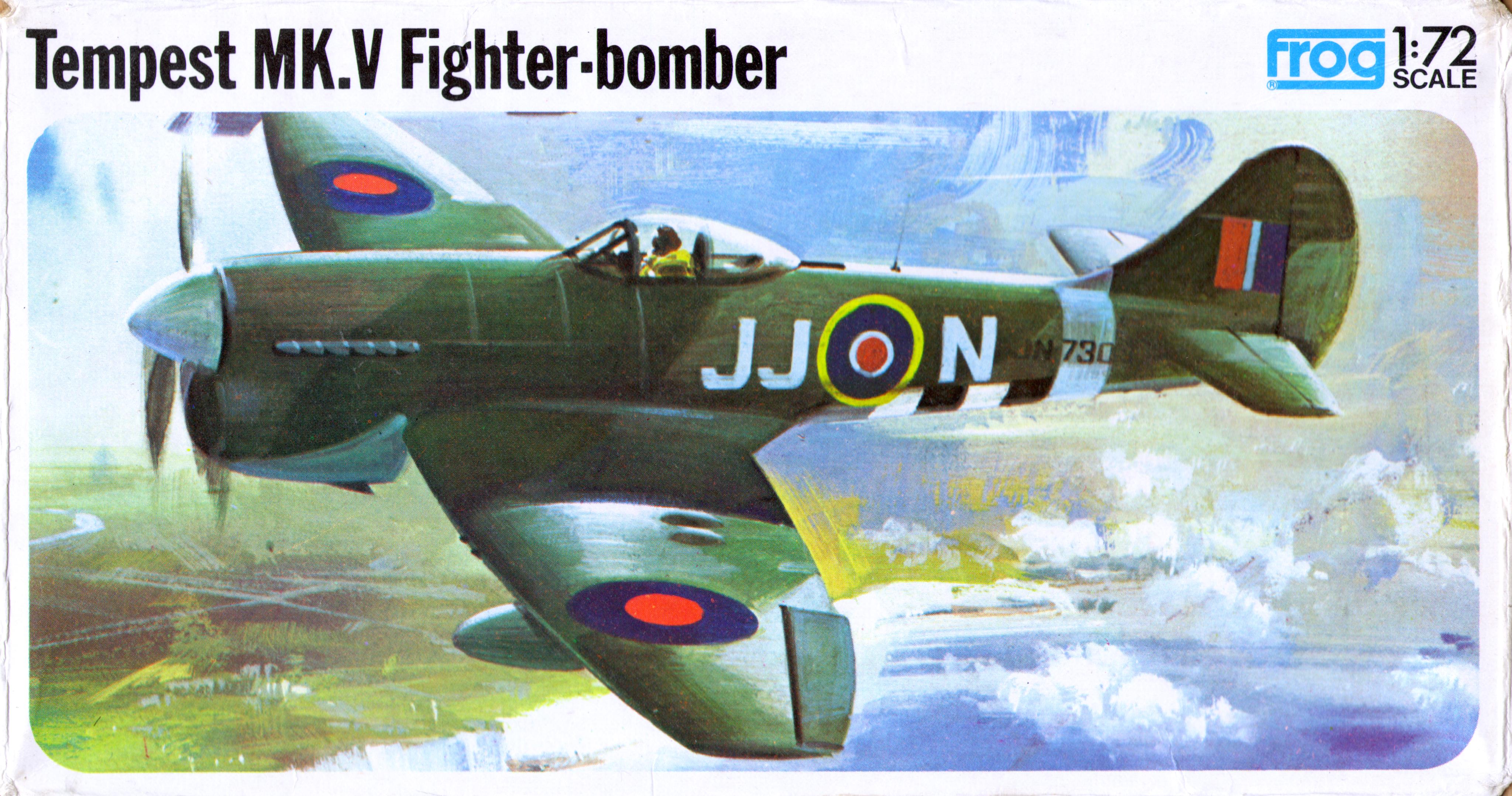
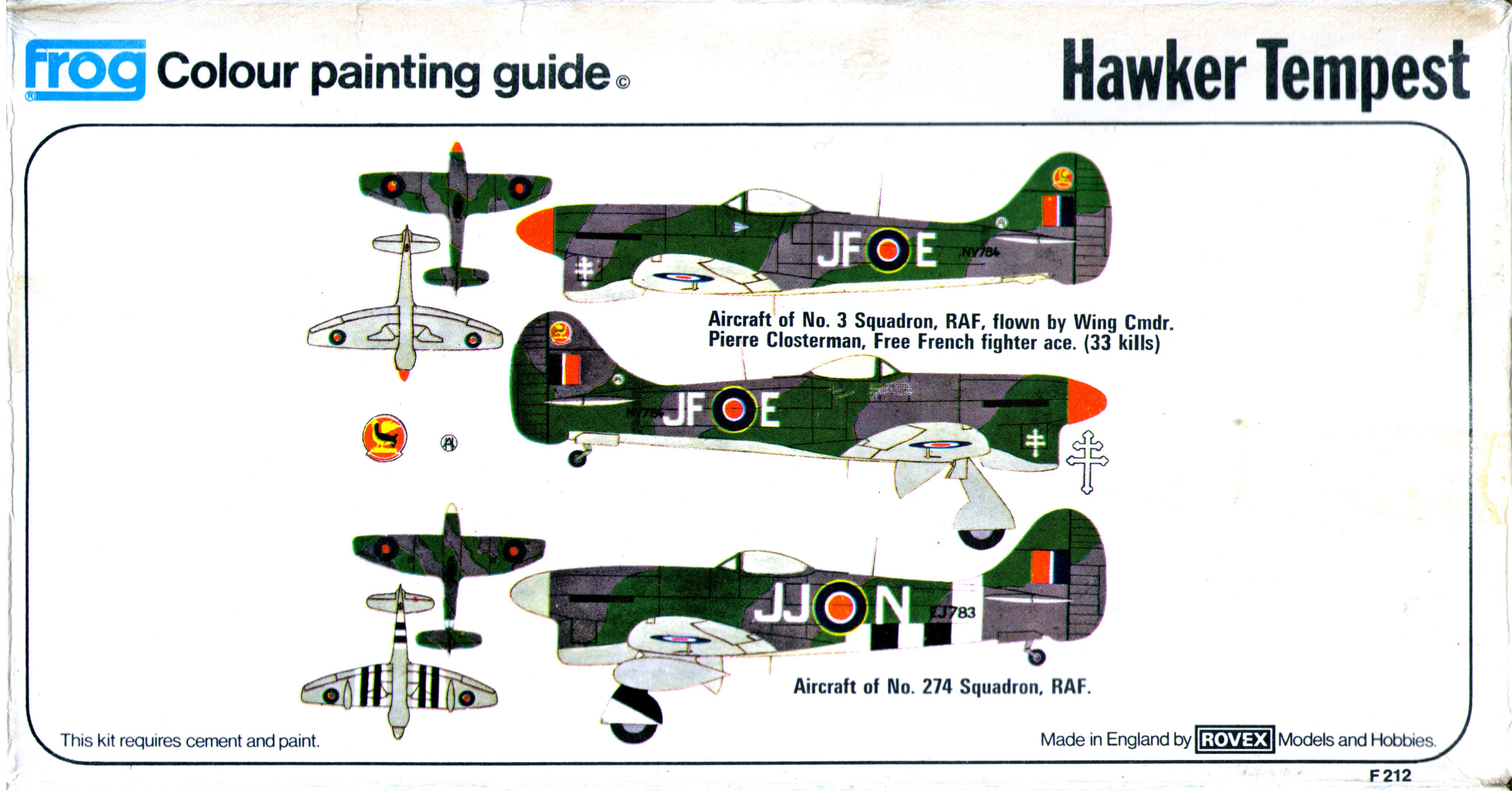
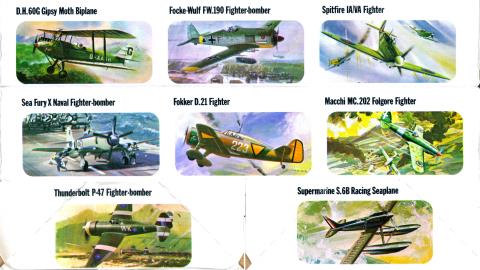


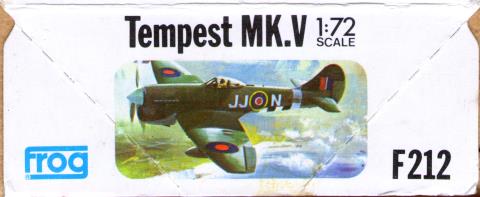
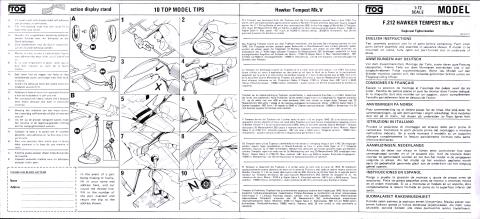
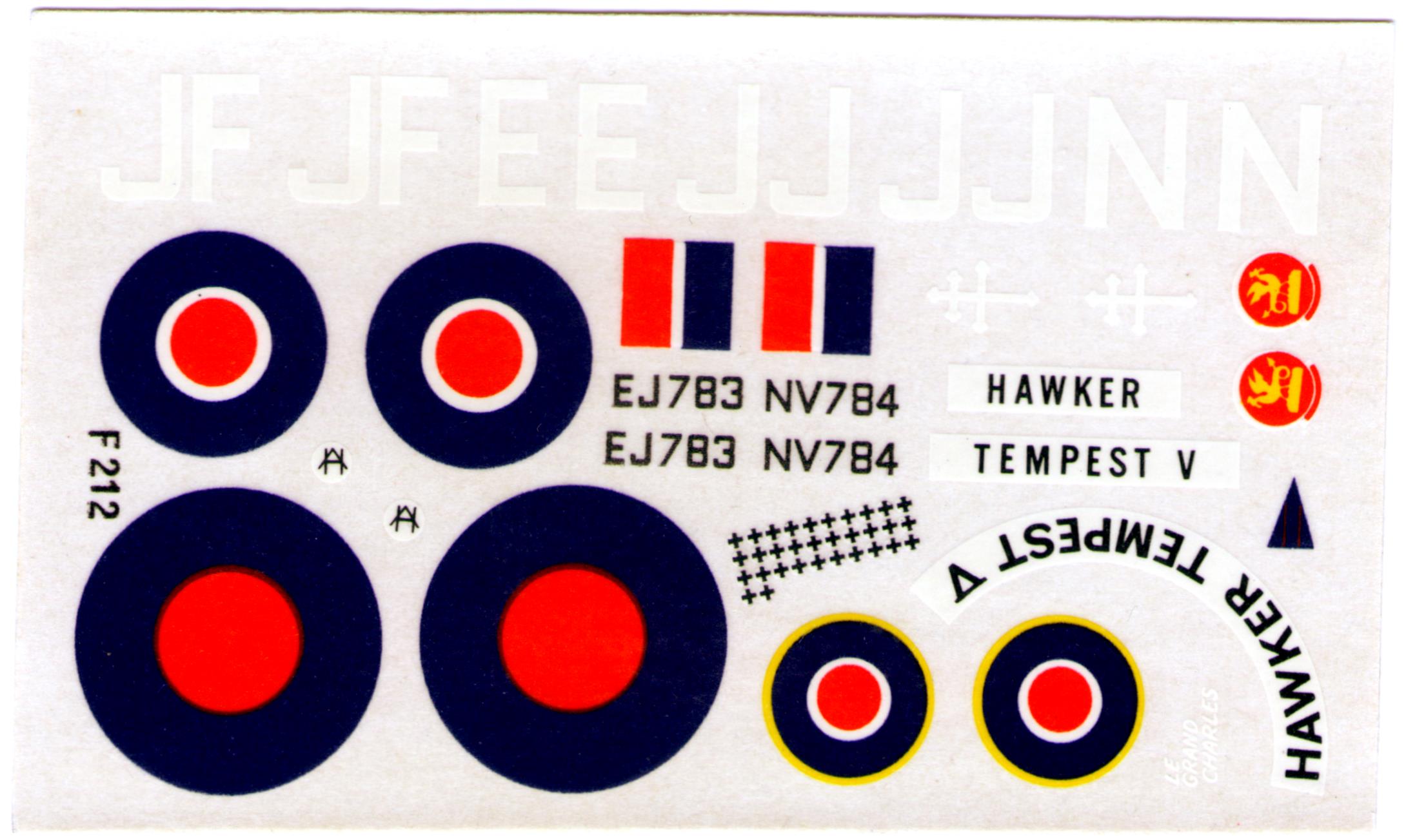
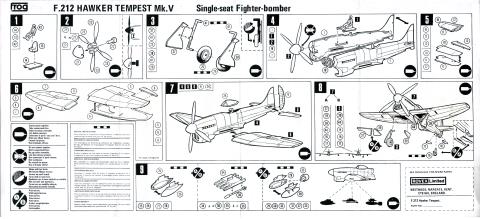
|
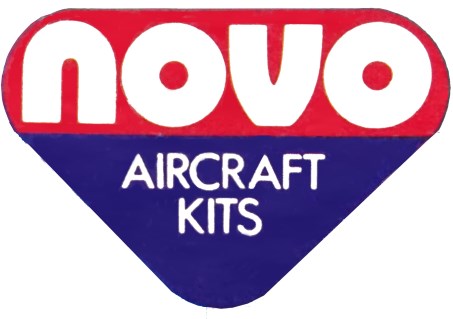
NOVO F212 Tempest Mk.V Fighter Bomber, Cat.No.78071 1979
|

Index 212, «Tempest» Scale model, bagged, Yaroslavl Chemical Plant "Lootch", 1979-90
1978-80
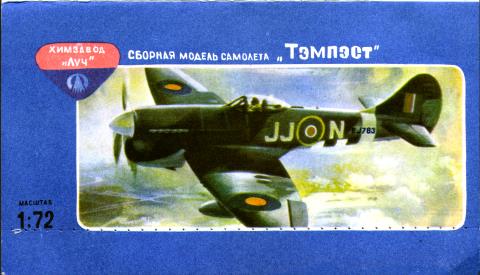
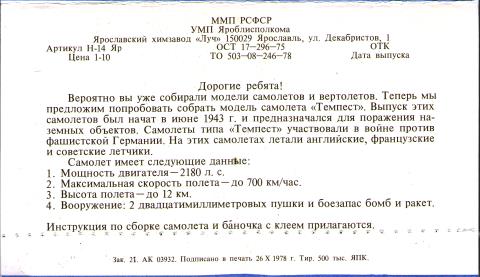
1980 - 86
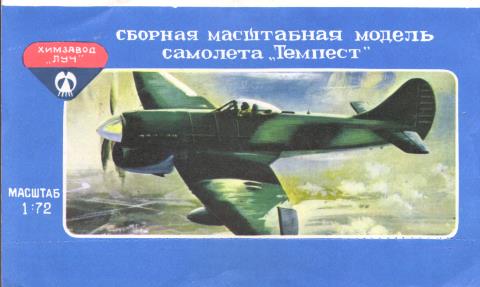
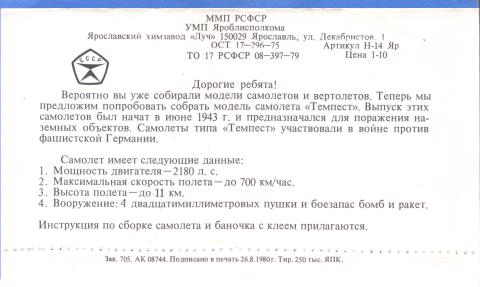
1986 - 90
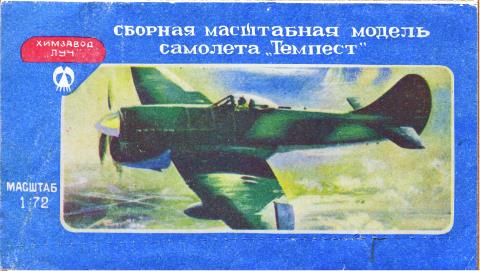
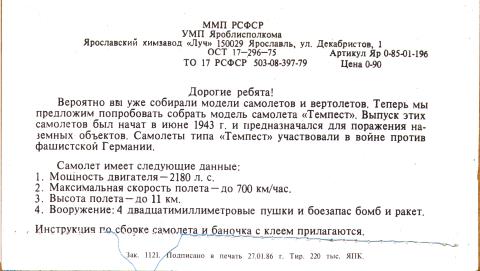
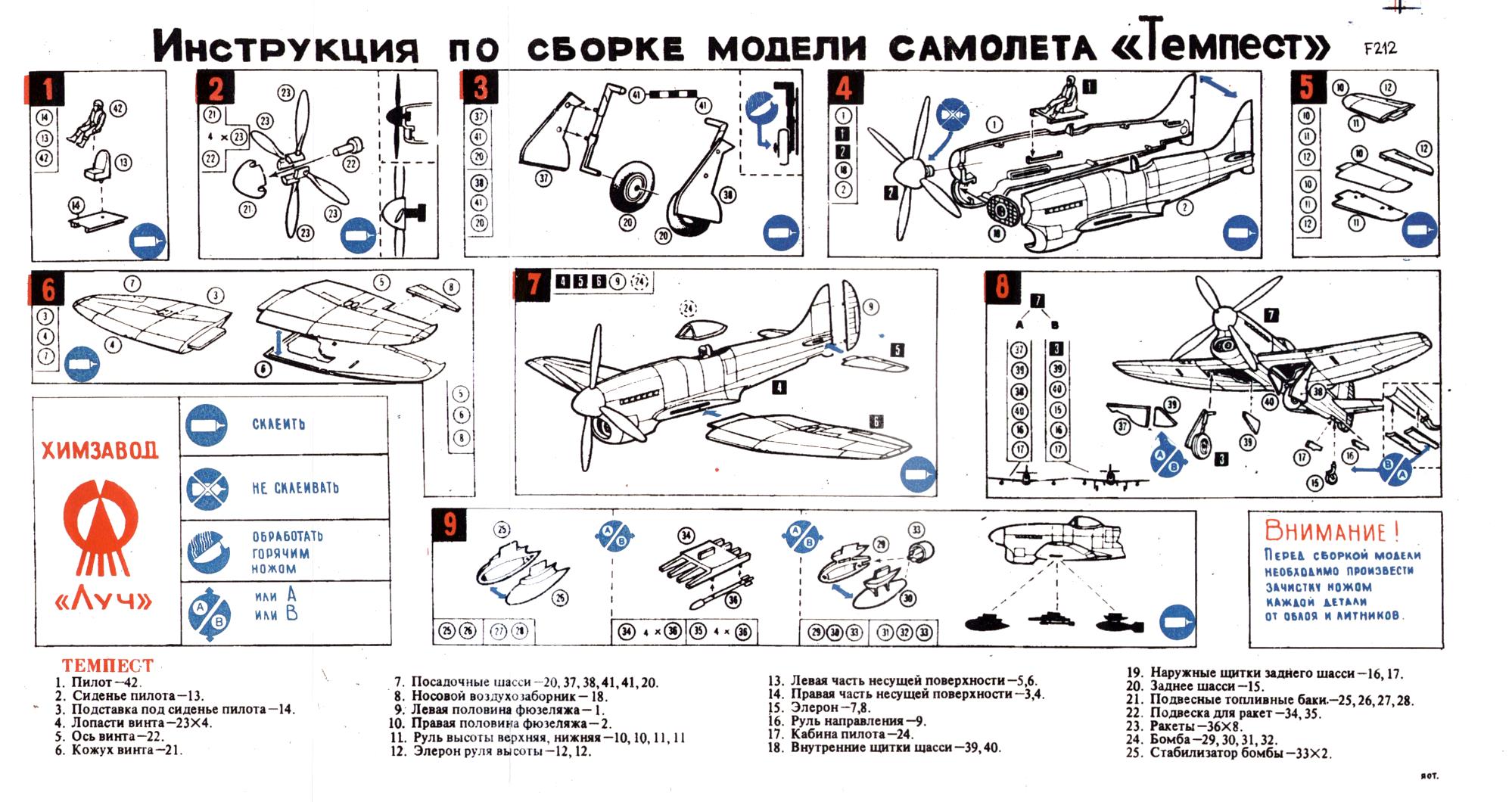
|

7222, «Tempest» Scale model, Zvezda, 2000-s
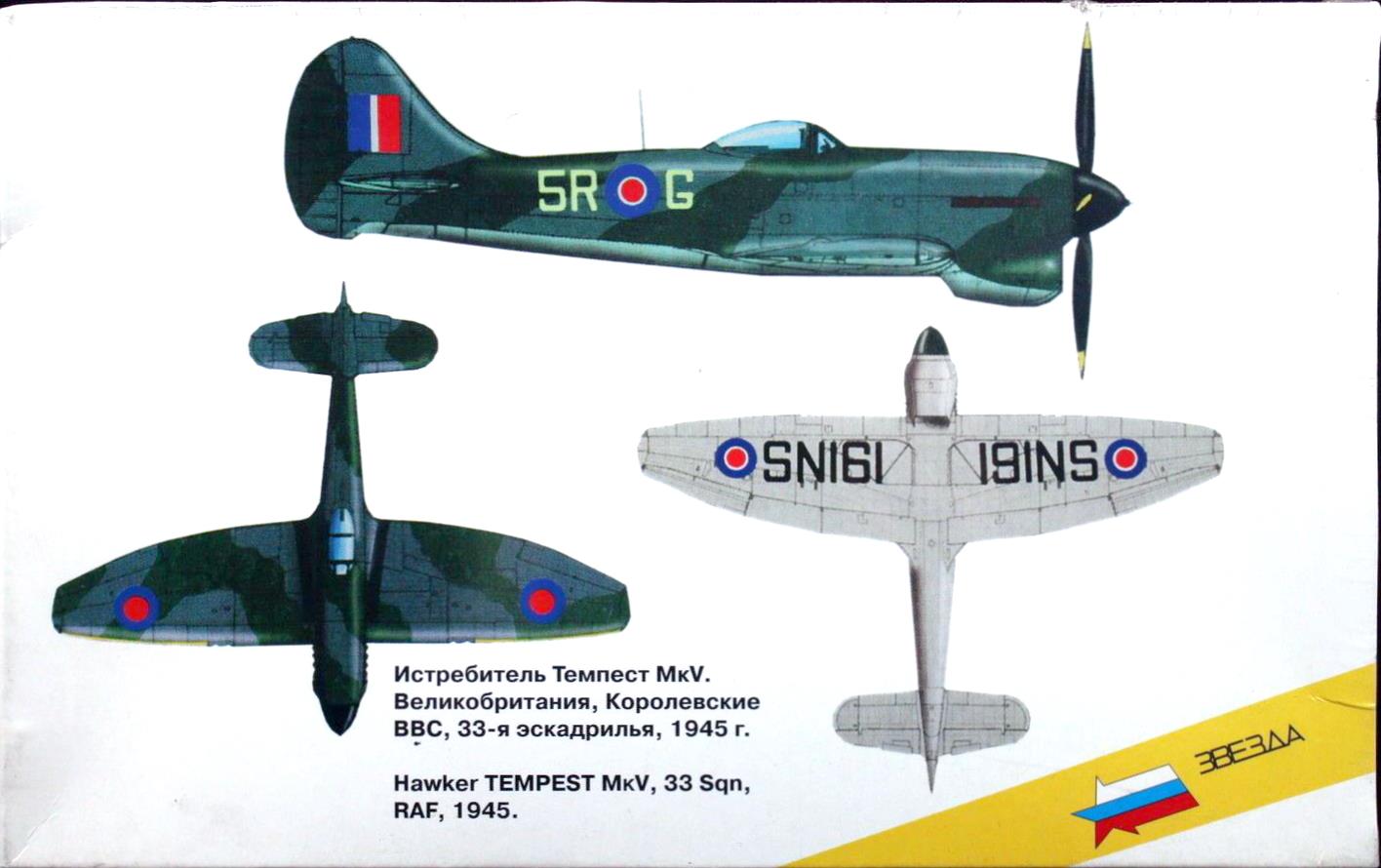
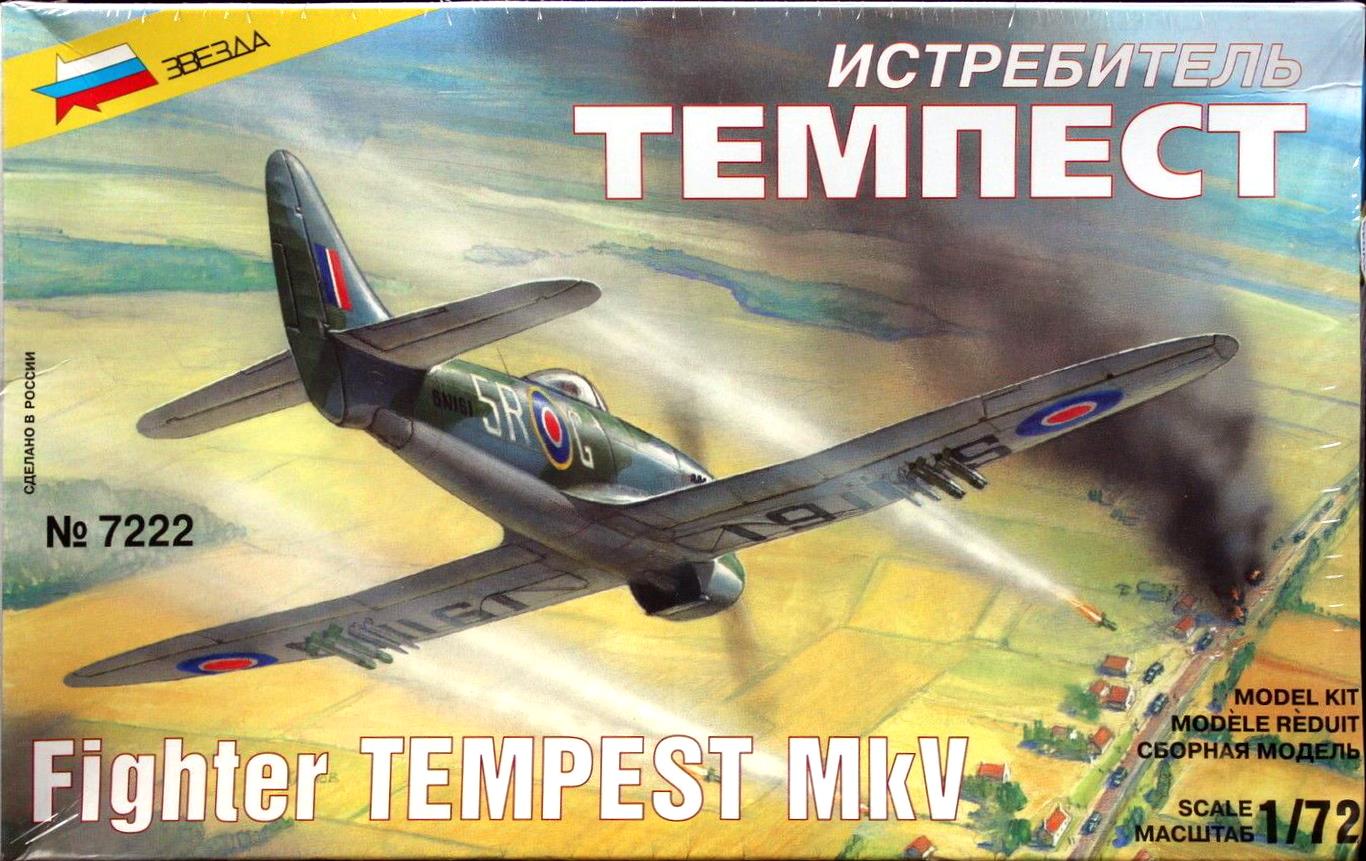
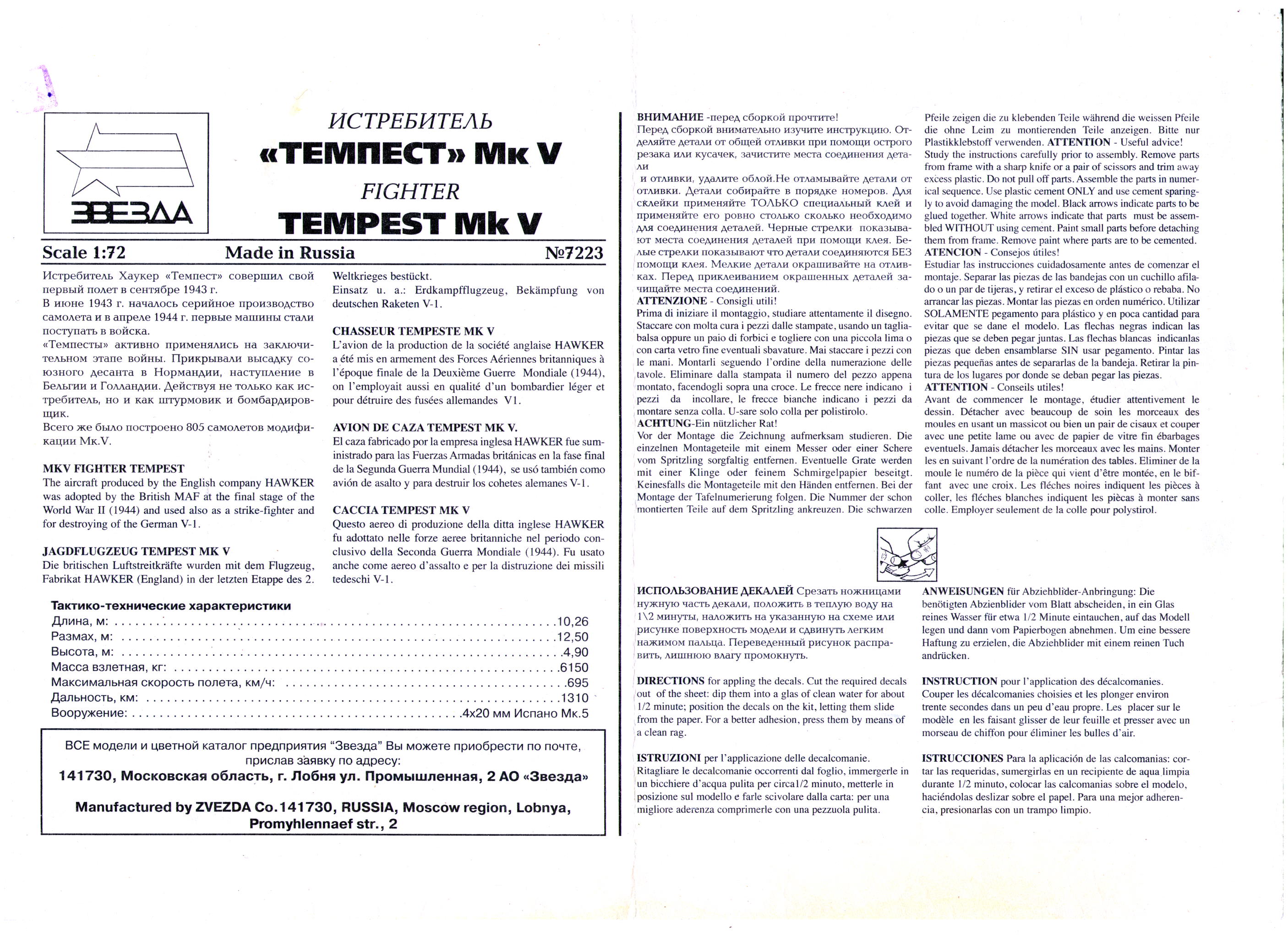
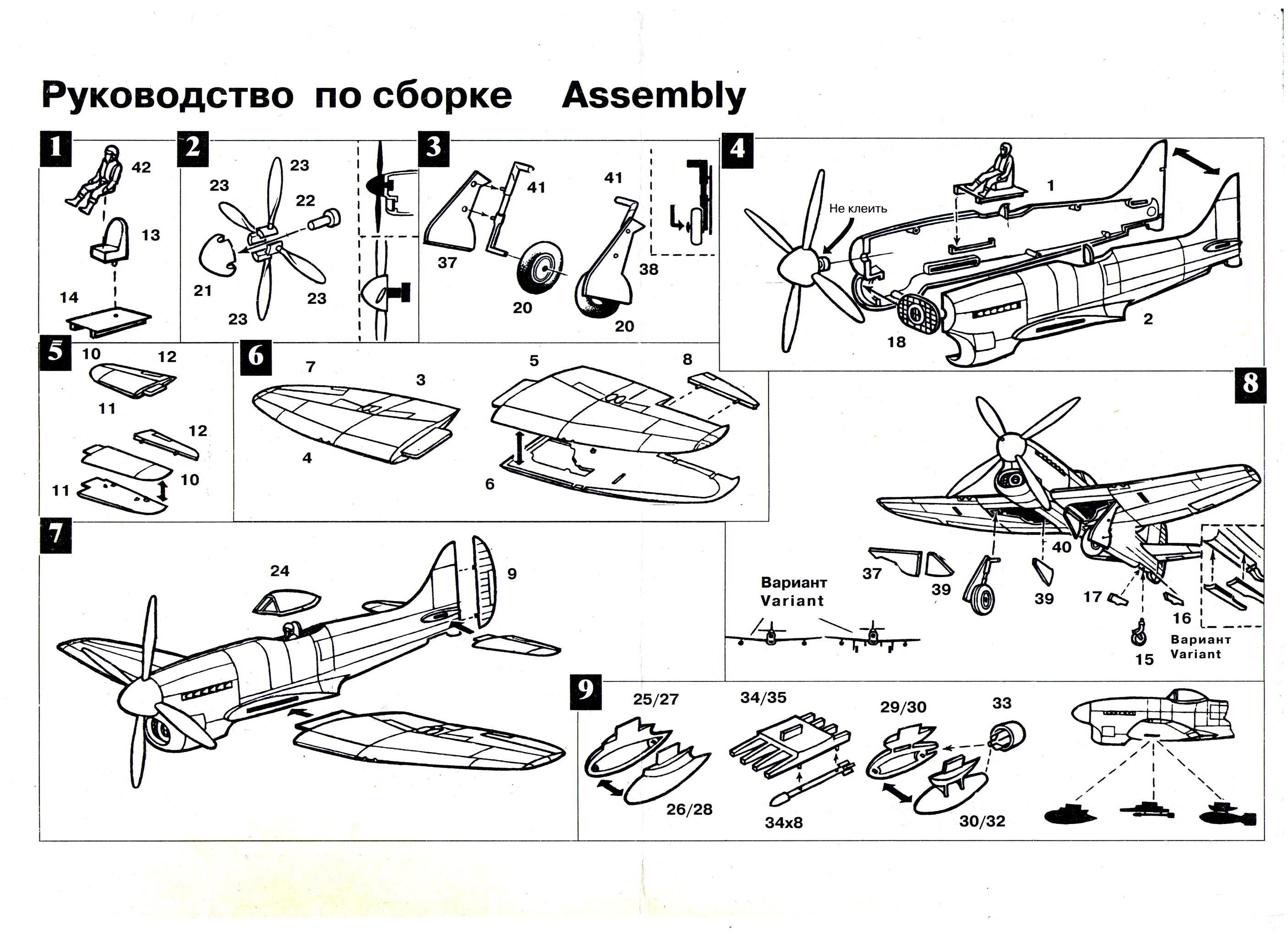
|
|
11.09.2017
|
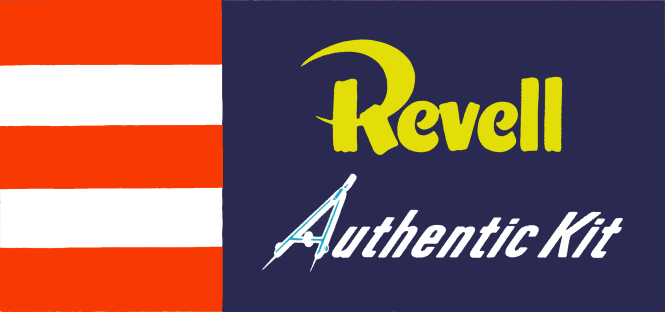
Revell H-620 Hawker Tempest Mk.V, Revell (GB) Ltd, 1963
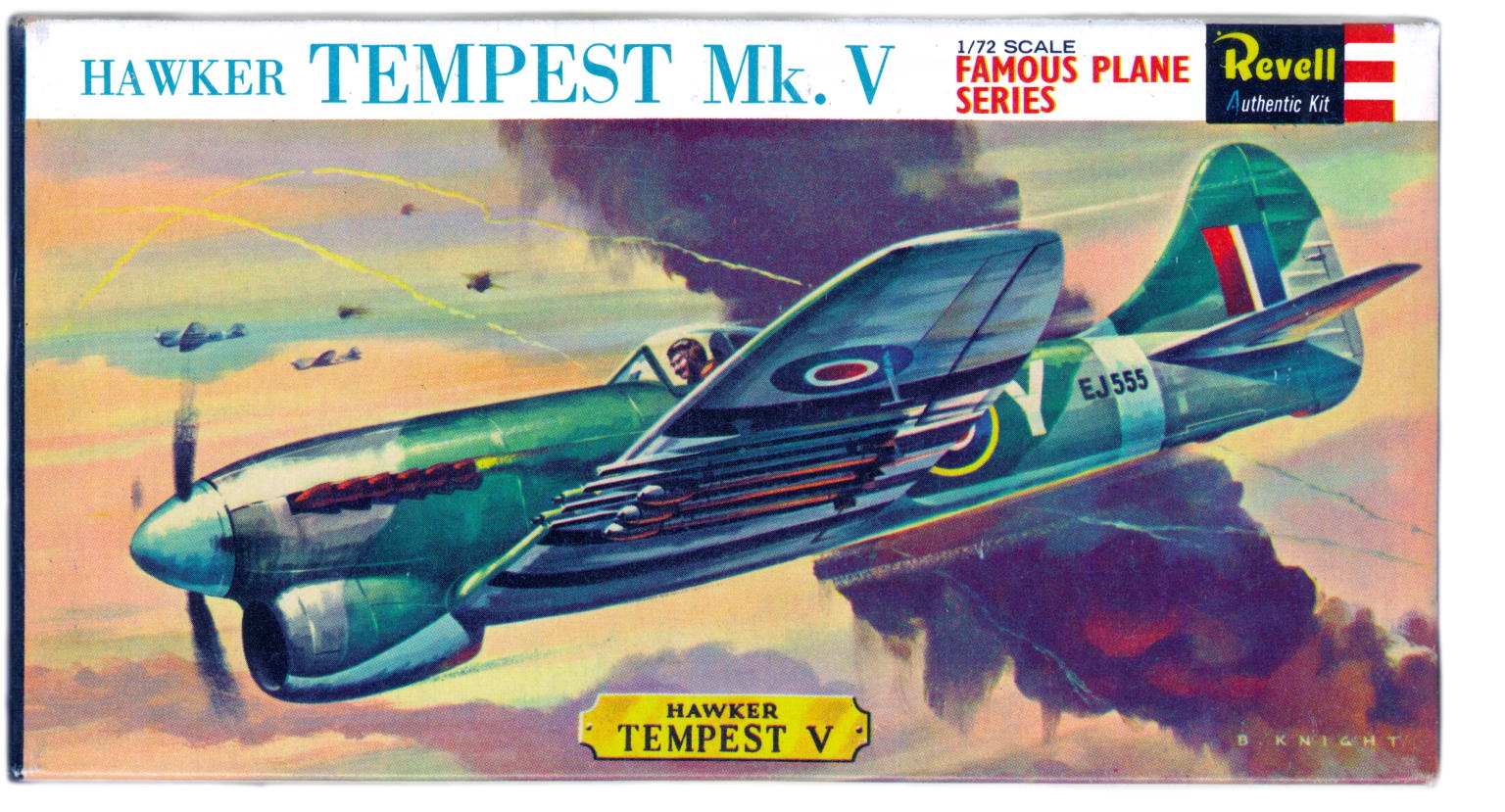
|


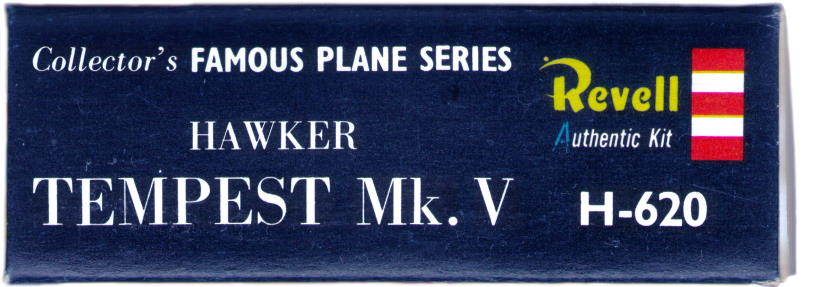
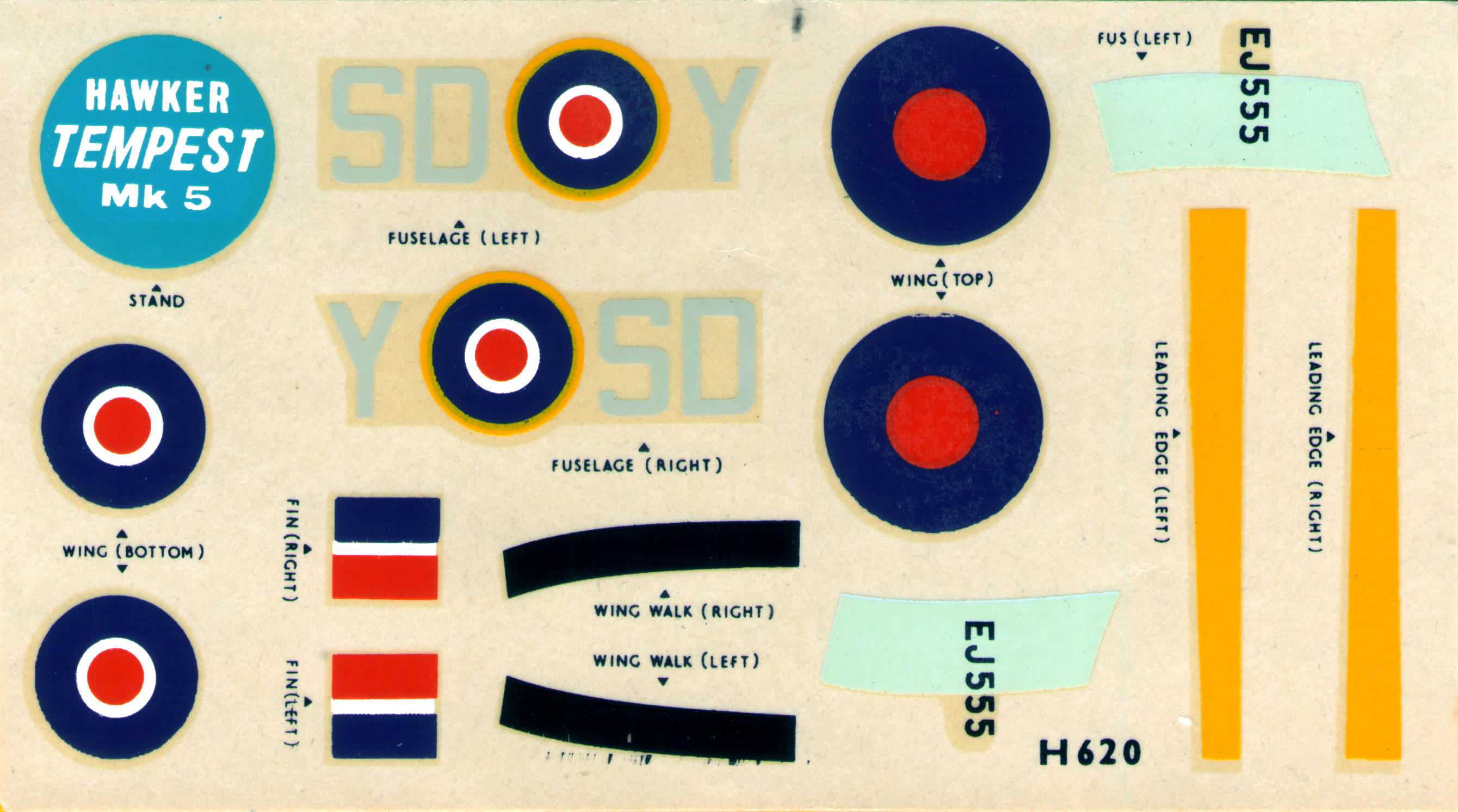
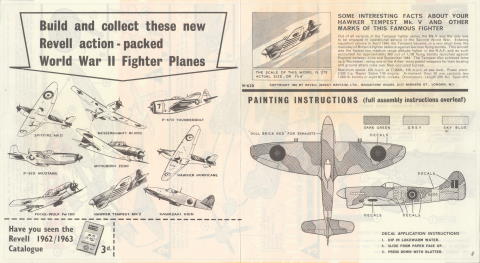
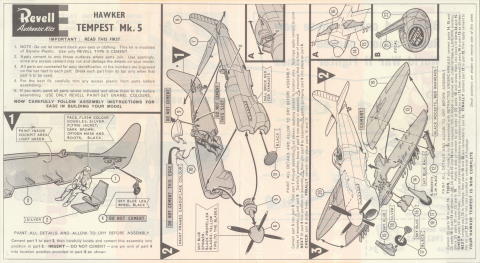
|
RECENT ADDITIONS
A FURTHER six new 1:72 scale plastic kits of World War 2 aircraft have been released by Revell, bringing the total in this series up to 12, all of which sell for 2s 11d each. The latest to appear are the Mustang P51-D, Hawker Tempest, Japanese Hien, Curtiss P-40-E Kittyhawk 1A, Messerschmitt ME-262 and Chance Vought Corsair F4 U1. Features of these kits include transparent cockpit canopies, pilot figures, authentic transfers, and undercarriages which can be assembled in either the retracted or lowered position.
A 12-page colourfulry-illustrated booklet, called Fighters of World War II, Vol 1, described and introduced by Bruce Robertson, has been released by Revell. It contains well-detailed colour illustrations and histories of the first nine Revell 1:72 World War II aircraft—the Spitfire Mk II, P-51D Mustang, P-47D Thunderbolt, Messerschmitt Bf109E, Kawasaki Hien, Hawker Tempest V, Hawker Hurricane, Zero and Focke-Wulf 190. Copies of this interesting publication are obtainable by sending in six box ends from any of this 2s 11d series, together with the form enclosed in the box, and sixpence to cover handling.
Airfix magazine November 1963 Vol.5 No.3
MODEL TALK BY PHILIP BURDEN
CONSTANT-SCALE
Revell's three new models are sure to please
Operation " Constant - Scale " is nearing completion and judging by early gains, the campaign will be an outstanding success. No, this is not a war communique but the facts concerning Re veil's entry into the highly competitive constant-scale field of plastic model aircraft. Several months ago they released the first of nine 1/72 kits costing 2s.11d. each, and recently the last three (P-51D Mustang, Kawasaki Hien and Tempest V) came off the production line. Reports from model stores indicate tremendous interest has been shown in the new Revell line and it seems that this company's somewhat late entry into constant-scale modelling is paying dividends.
What are these new models like? A quick answer is that they are clean, well-detailed, and have excellent transfers —but are not 1/72 models. Although it is unfortunate these last three are not to scale, I believe many enthusiasts will overlook this point and show no hesitation in purchasing them.
Finally, the Tempest—long awaited by many people—is a well-made job and worth acquiring. Few people will be able to fault this as a model and for once it seems a manufacturer has mastered the problem of providing reasonably realistic under-wing rockets.
RAF Flying Review August, 1963, Vol. XVIII, No. 12
Modelling world
New British World War II aircraft kits
The Typhoon's stable-mate, the Tempest, has been modelled in 1/72 scale by Frog and Revell. The Frog kit has a generally accurate outline, but the Revell version of the same mark suffers from an inaccurate wing planform and aerofoil sections.
James Goulding
Aircraft Illustrated 1972-11
Memories, models, and markings
by JAMES GOULDING
More often than not, aircraft designers use a progressively thinner thickness/ chord ratio section from the wing root out to the wing tip— which has the effect of increasing the head-on taper even more than if a constant section had been employed. For example, the Hawker Tempest had a wing root section of 14.5 per cent thickness/chord ratio (ie the depth of the wing root is 14.5 per cent of the wing width, or chord, at that point) whereas at the tip it reduces to 10 per cent. Even if a constant thickness/chord ratio is maintained throughout the wing, the reduction in wing width, due to the plan view shape, will mean a proportional reduction in wing depth. Reduction of wing width along an elliptical plan form, given a constant or reducing thickness/chord ratio section, will produce a curved taper head-on—as, for example, on the Spitfire. Accuracy in wing shape, either in section, thickness or plan form, is of vital importance to the overall appearance of a model...
AIRCRAFT ILLUSTRATED JANUARY 1969 VOL 2 No1
|
|

Matchbox Hawker Tempest Mk.V, Lesney group, 1975
|
|
MODEL ENTHUSIAST
A choice of Tempests
The Lesney 'Matchbox' series of 1/72nd scale kits offers a fair balance between the commonplace and the unusual, and this company's Hawker Tempest falls somewhere between the two for, while it has been modelled twice before — by Frog and Revell — in the same scale, this new kit offers parts enabling a choice to be made between the Centaurus V-powered Mk II and the Sabre V-powered Mk VI.
This is one of the best kits yet to appear in the 'Matchbox' series, being both accurate and easily assembled. All joints are a good fit and special mention should be made of the way in which the alternative 'power eggs' mate with the main fuselage sections. There is not much detail in the cockpit and the panel lines and control surfaces are rather heavily engraved, but these are minor shortcomings and do not seriously detract from the overall quality of the kit. It comprises 37 parts, moulded partly in olive drab and partly in yellow, and they show no signs of any flash whatsoever. The undercarriage legs are moulded in one with the doors, but they still look good because they are to scale.
The provision of alternative parts extends to separate spinners for the two engines, that for the Tempest II being longer and more pointed than that for the Mk VI. With its modest 3 Op UK price tag, this kit represents very good value and should prove very popular, and particularly so as it includes a very attractive decal sheet providing the markings for a Tempest II of No 7 Squadron, Royal Indian Air Force, based at Poona in 1949, and a Tempest VI of No 6 Squadron, RAF, based in Cyprus in November 1945. As is usual with the 'Matchbox' series, the painting information provided is woefully inadequate and, in the case of the Indian machine, totally misleading as it shows a light blue overall finish whereas, in fact, the aircraft was silver overall.
Air Enthusiast 1975-06 vol.08 no.06
KIT COMMENT
MATCHBOX TRIO
THREE NEW 1:72nd SCALE AIRCRAFT TYPES
AMONGST the latest releases from Lesney in the 1:72nd scale Matchbox aircraft series are three very useful models for collectors of British military aircraft. There's also a bonus in that one of these, the HS.125, a series 600 version has been provided making it ideal for the civil modeller. The other two kits are a Westland Lynx helicopter and a two-in-one kit of the Tempest II and VI.
Perhaps the most interesting, and we daresay the most popular of the three, is the Tempest. This attractive kit comes with alternative noses for either the radial engined Mk.II or the more prolific Sabre-powered Mk.VI. The markings on the decal sheet also show originality in that the Tempest II has been given the attractive post-war Royal Indian Air Force roundels. The Mk.VI is in standard RAF grey/ green and the codes and insignia of No. 6 Sqdn.
The building of the kit presents few problems. The decision as to which variant is required comes after the fuselage halves have been stuck together. If the radial engine is used an additional job is entailed in cutting off the propeller tips (2½-3mm) and re-rounding the points as the Hercules engine had a smaller diameter prop.
We chose to make the Mk.II, mainly because the Frog and Revell kits of the Sabre-powered version were already in our collection. At the same time readers will note that we discarded the kit decals and produced an RAF aircraft as we thought that the experience might be worth passing on.
The kit parts fitted well together but we found that the joints around the wing roots needed rather a lot of filling. It is also worthy of note that Lesney have added (rather crudely, perhaps) some detailing in the wheel wells at this stage. Although not strictly correct this detailing is better than none at all and can be added to by the stickler for detail.
Wheel and other undercarriage parts are well moulded. The oleo legs are integral parts of the main doors but nevertheless look accurate enough. To get the other parts of the wheel well covers it is necessary to cut up part 32 which has all these pieces moulded in one so that should the modeller require the undercarriage in the up position this can be done. This aspect is again an interesting innovation in this kit. It is, perhaps, a minor point but one worthy of note by other manufacturers as the saving in plastic is useful and does not waste parts which may otherwise be consigned to the spares box.
In painting the model we relied on the excellent art work provided on the penultimate page of Profile No. 197 which gives details of all Tempest versions. This particular five-view colour drawing is of Tempest FB.II MX820 when serving with No. 54 Sqdn. at RAF Chilbolton in March 1946. Apart from having a standard RAF Temperate land colour scheme modellers will have to add bomb racks under the wings.
We used the decals for the Mk.VI model from the kit for the national markings, painted on the Sky tail band, instead of using the kit offering, and also painted the white recognition bars common to this type on the fin and rudder, tailplane and round the nose. Squadron codes HF:T and the serial were made from Dridec sheets as were the underwing serials. One other minor constructional addition was an aerial mounted on the fuselage aft the cockpit canopy.
Checking against known accurate drawings we found few faults to find with the Tempest. It lacks detail in the engine area which, although covered by a very large propeller boss, does show more than the rather blank interior of the model. Panel lines although deep, by some standards, were not too obtrusive but the cockpit area lacked detail. Even so we thought that this model had set new standards for Lesney and at 30p was well worth buying.
Aviation News Vol 3 Num 17 24 January - 6 February 1975
|
|
|
|

Heller Ref. 159 Hawker Tempest Mk.V, Le Jouet France group, 1978
|
|
HAWKER TEMPEST V
Manufacturer: Heller
Scale: 1:72nd
Price: 85p.
Heller's new Tempest V is undoubtedly a quality model compared to previous offerings in the same scale. I found that the general outline shape was good except for the bottom of the fin and rudder which is possibly a little too deep. This can, however, easily be filed down. The kit is remarkably flash free but on the review sample I found the lower port mainplane aileron had suffered some distortion but again within limits and could be corrected.
Detail in the cockpit is adequate and there is room for the specialist to add little extras for realism as the canopy can be left in the open position if so desired. When putting the fuselage halves together I experienced some difficulty due to the tight fit of the radiator unit which made the front part of the cowling spring apart unless some adhesive tape was used to prevent this.
The wing assembly went together particularly well and no filler was required at any point in the construction. As far as the undercarriage is concerned I advise those making this model to have a quick look at their earlier efforts with the Matchbox version of the Tempest and see the amount of detail that has been added to the Heller one. This is probably one of the best kits I have made from this point of view and the workmanship that has gone into the wheel wells, undercarriage legs and doors is superb. If anything the construction is too delicate and great care must be taken when the model is complete or breakages will occur.
The fixing of the tailplane needed a little body putty and some rubbing down. The fit was good but the purist will, I am sure, prefer to get rid of the small gap that appears when the parts are glued in position. The number of added details such as footrest, antennae and pitot tube should be added last of all before painting.
Two sets of decals were provided but I should have thought that with a kit of this excellence Heller could have thought up some more original schemes than those of Wg.Cdr. Roly Beamont and Pierre Closterman. Far be it for me to criticise these famous fighter pilots but there were many other aircraft equally worthy of reproduction and not echoing things done before. One small point also worthy of note is that Beamont's aircraft was a Tempest V, series 1, serialled, as the decals show, JN751. This machine differs from that in the kit by having larger diameter wheels and long barrel cannon fairings. The wheel problem could not be overcome but the cannons could, and slight modifications were made to the kit as I wanted to use his aircraft as my model.
One other point of note is that the codes applied to the aircraft are shown in cobalt blue. Was this correct? Shouldn't they have been in Sky?
There are very few faults in this excellent model and those that I have illustrated are very minor ones. It was a delight to build.
Ian Deas
Scale Aircraft Modelling OCTOBER 1978 VOLUME 1 NUMBER 1
MODEL ENTHUSIAST
Gladiator and Tempest a la Francaise
The Tempest kit accompanying that of the Gladiator really is outstanding. Consisting of 45 highly-detailed parts, it cannot be faulted on the score of accuracy and it assembles perfectly. The undercarriage, in particular, provides an excellent example of delicate modelling. Even the interiors of the wheel wells are detailed and the interior of the radiator intake is deserving of special mention. The cockpit interior is well furnished, two drop tanks are provided, and the accompanying decals are devoted to Tempest Mk Vs flown by W/C R P Beamont and W/C Pierre Closter-man. While the kit itself cannot be faulted, the decals display one fault — very bright blue rather than grey being used for the unit codes. Both the Gladiator and Tempest Mk V kits retail in the UK at 85p and are well worth every penny.
F J HENDERSON
Air International 1978-12, Vol.15, No.6
|
|
|
|
|